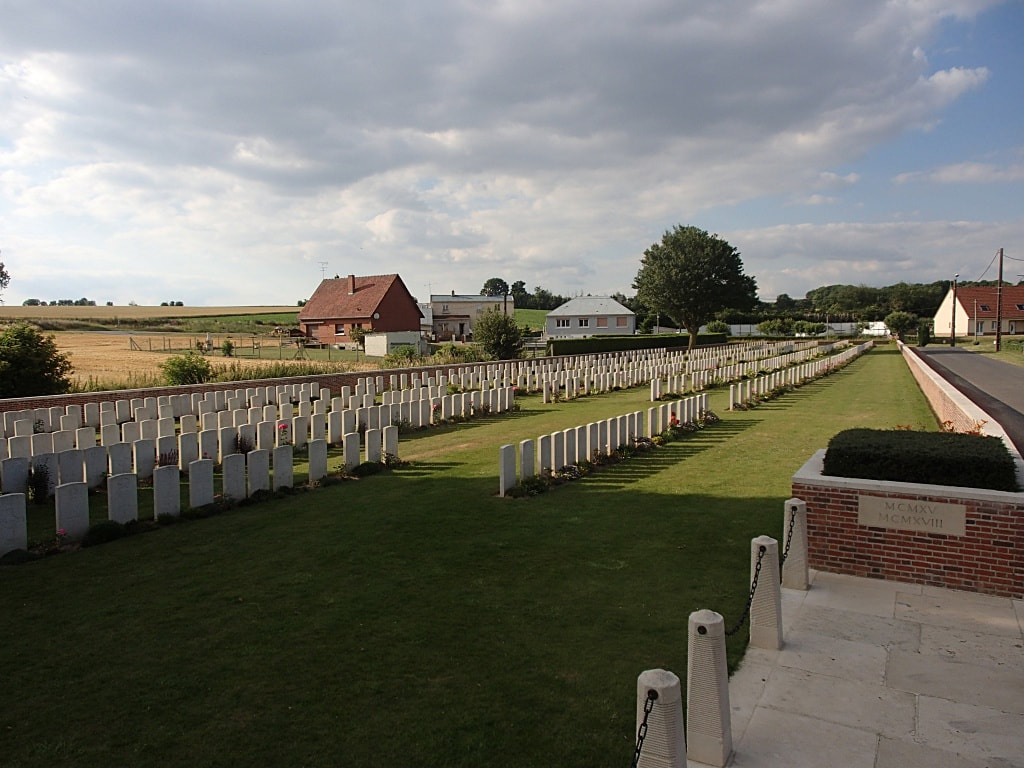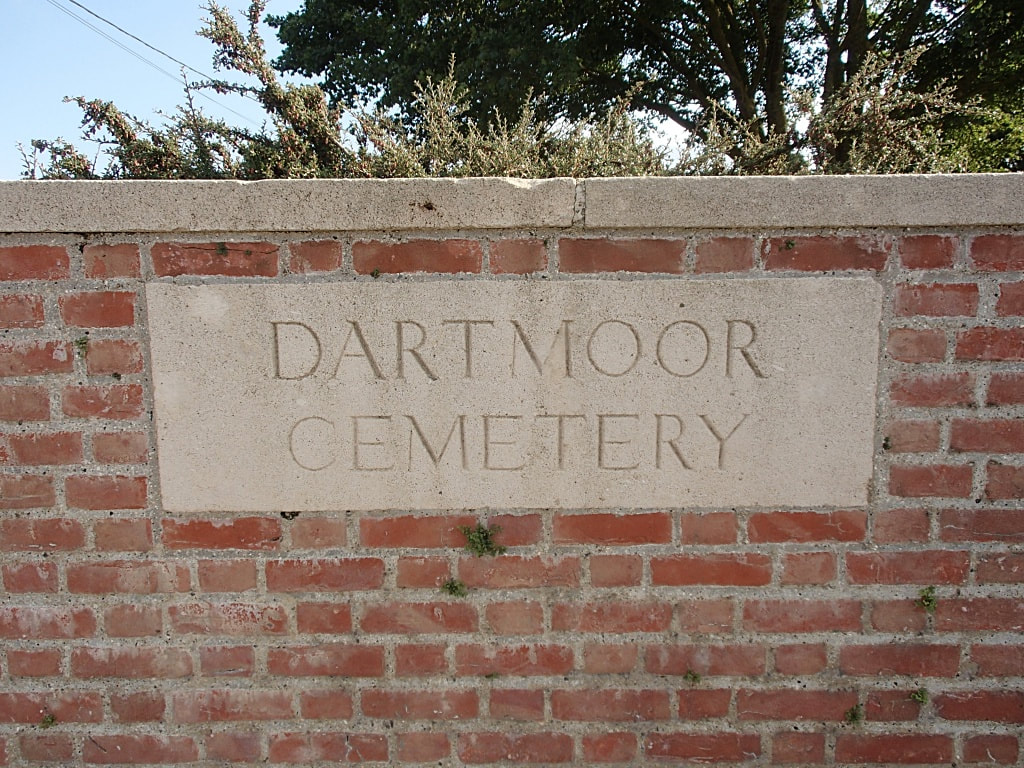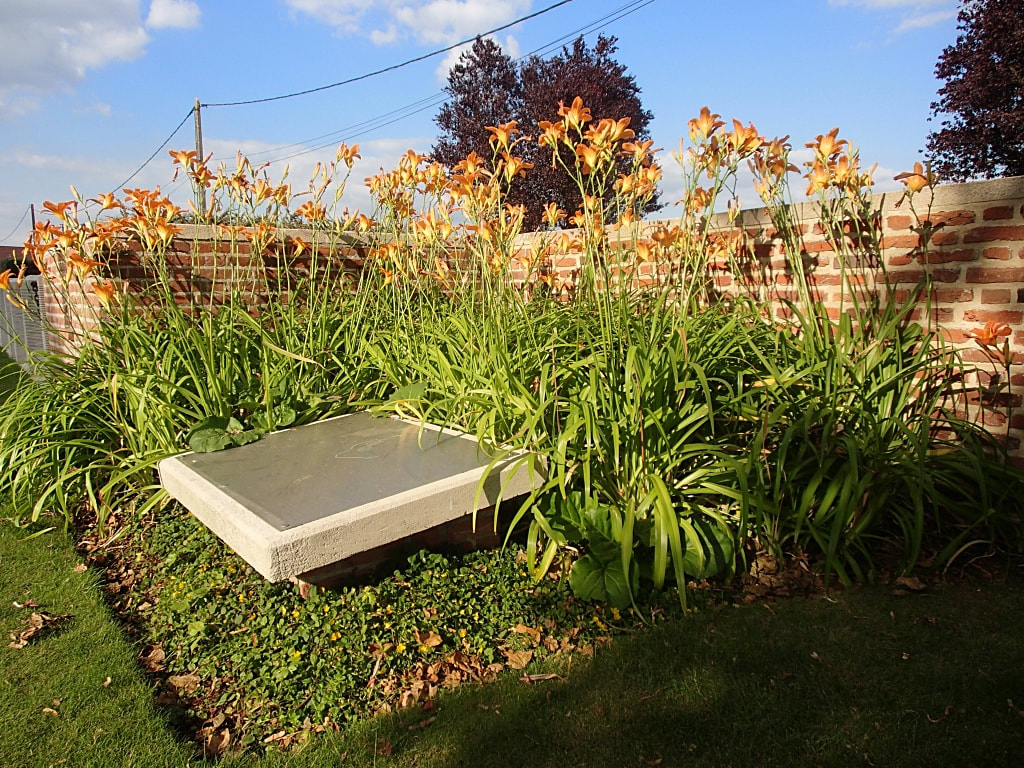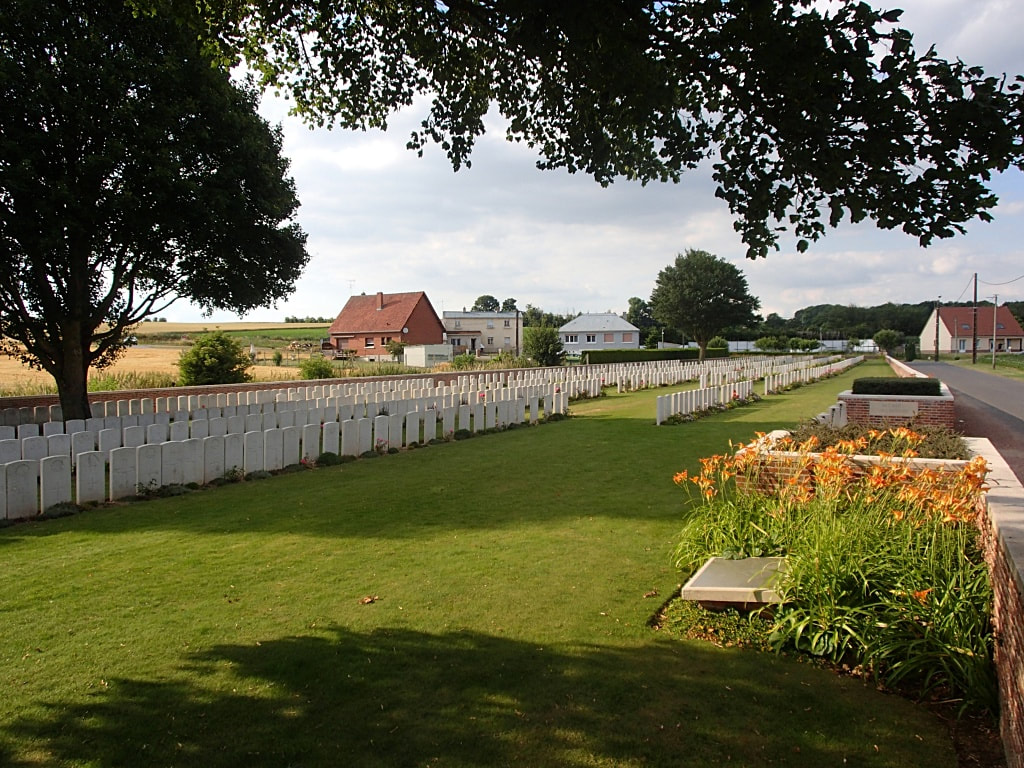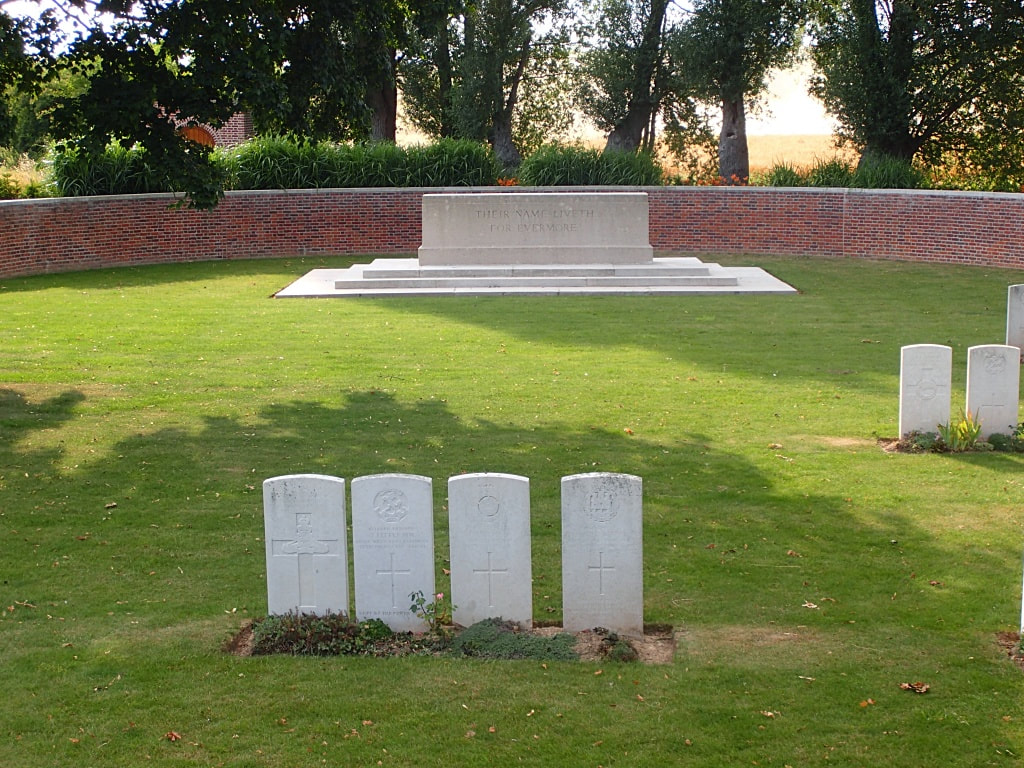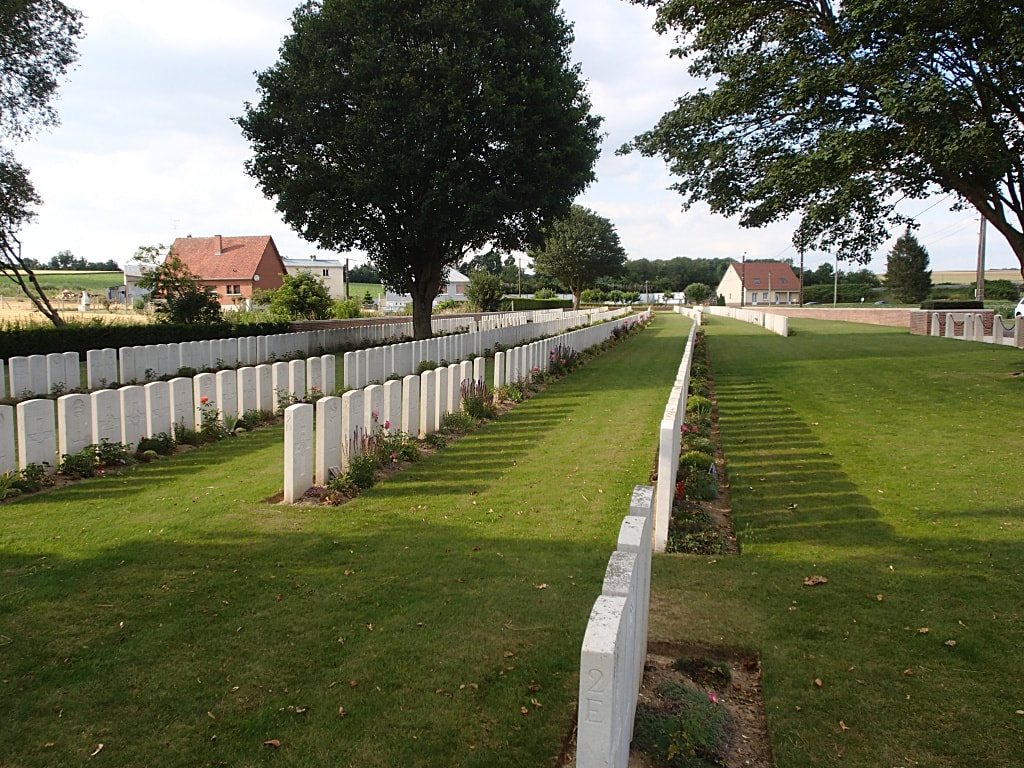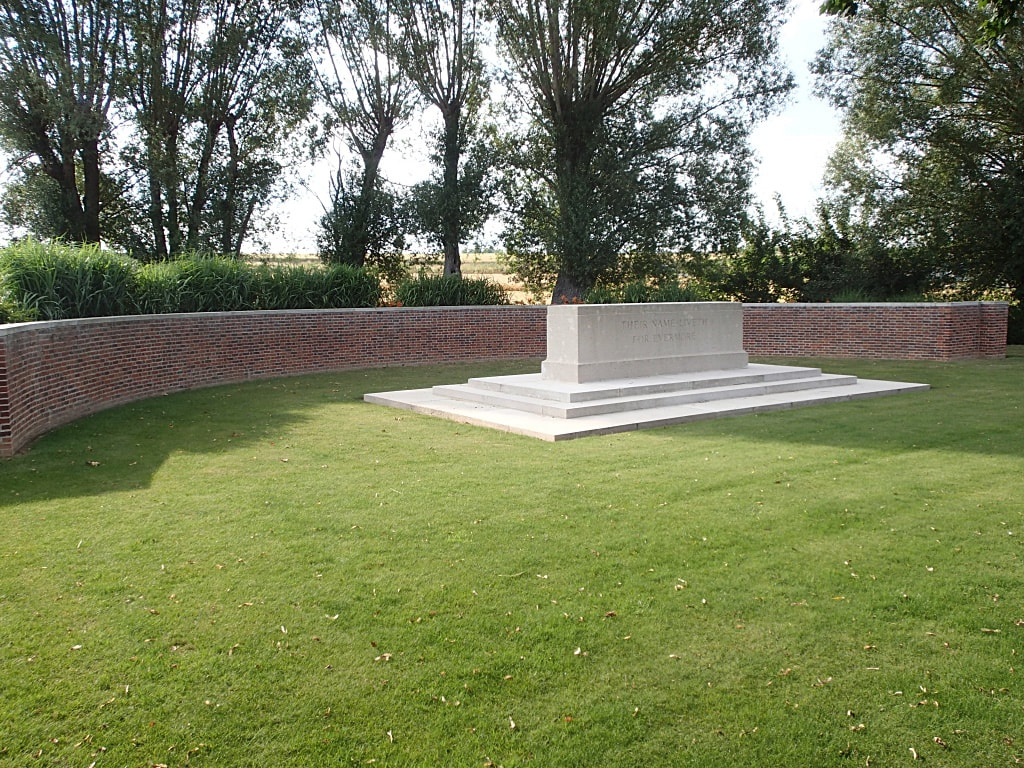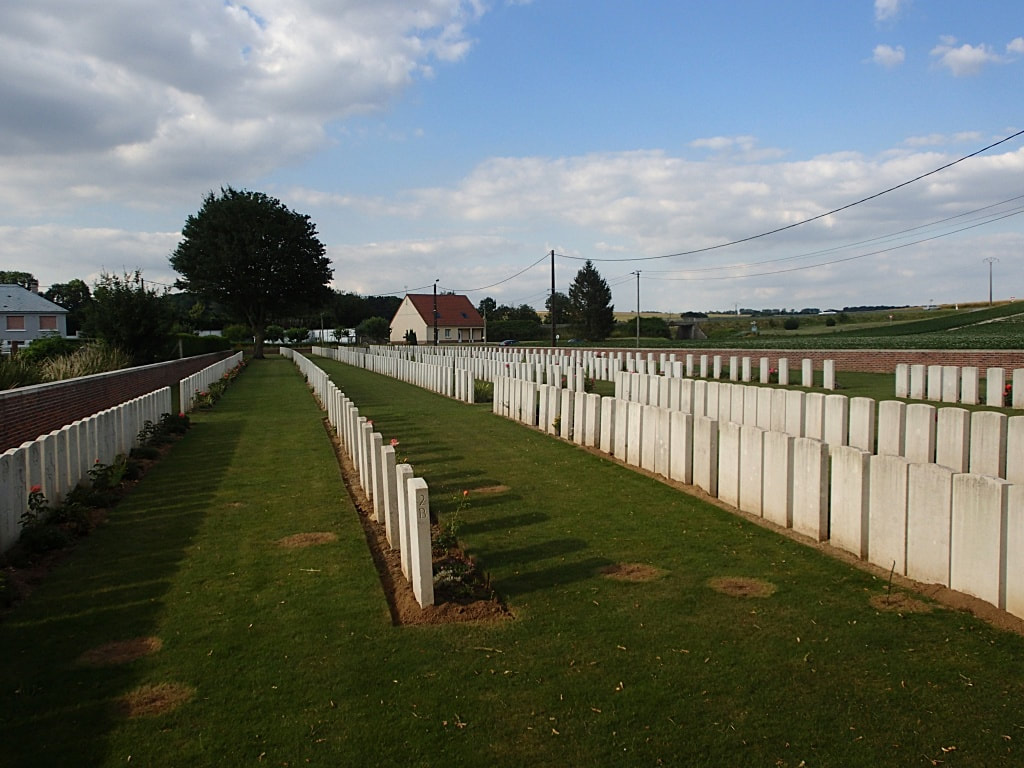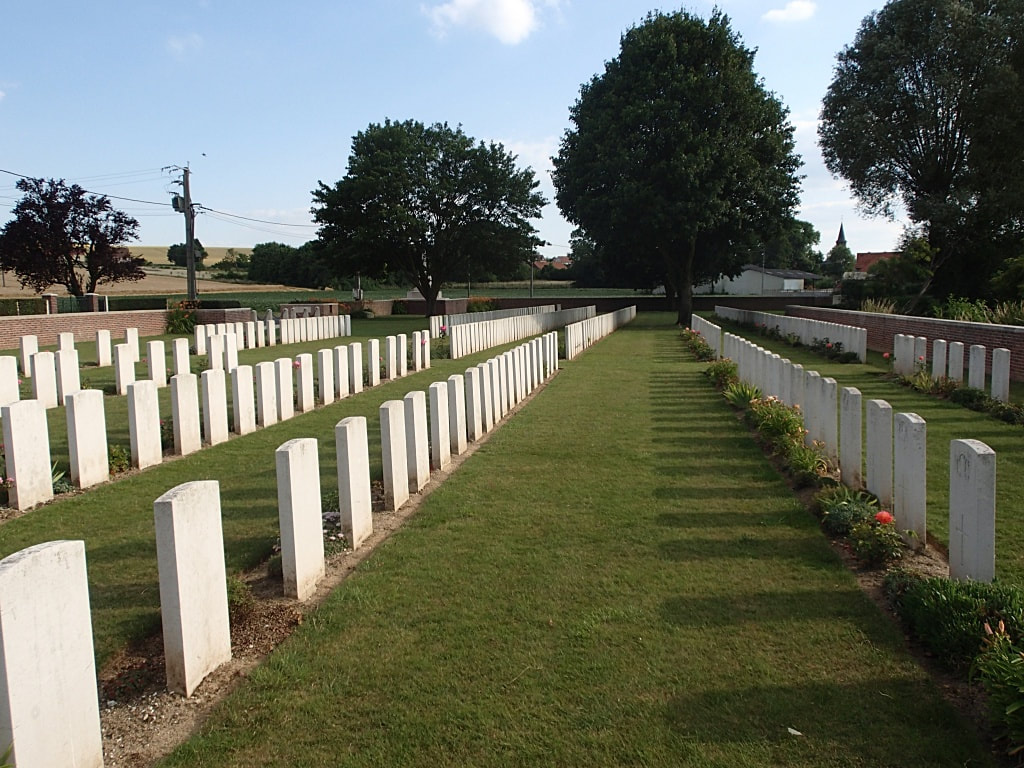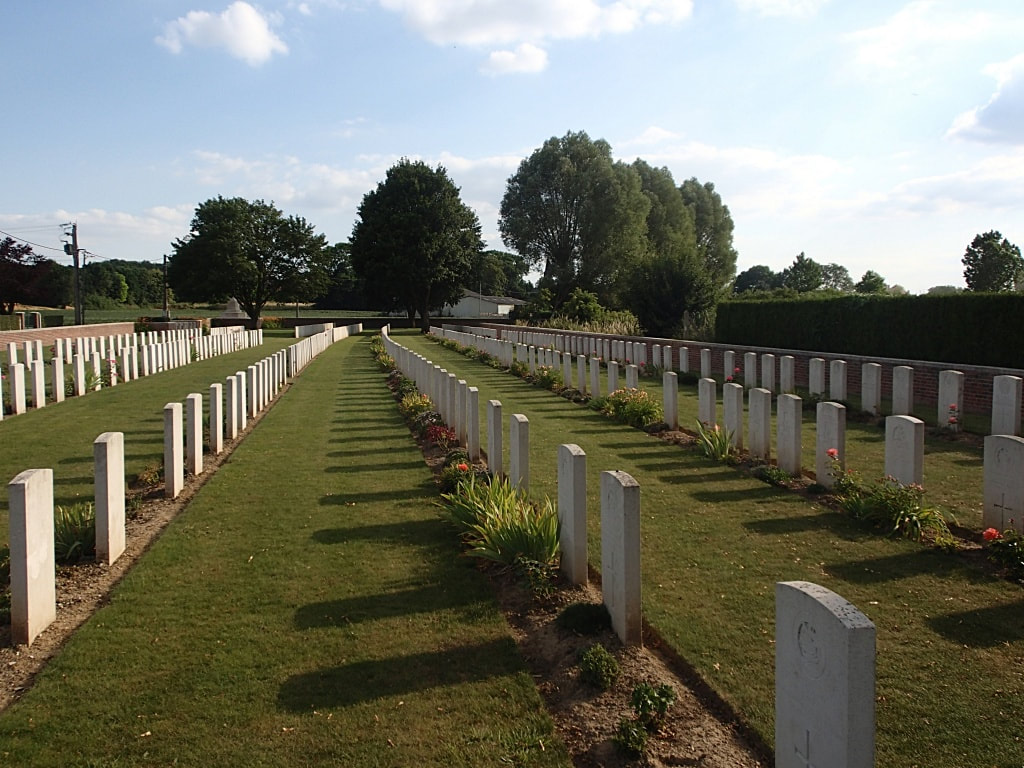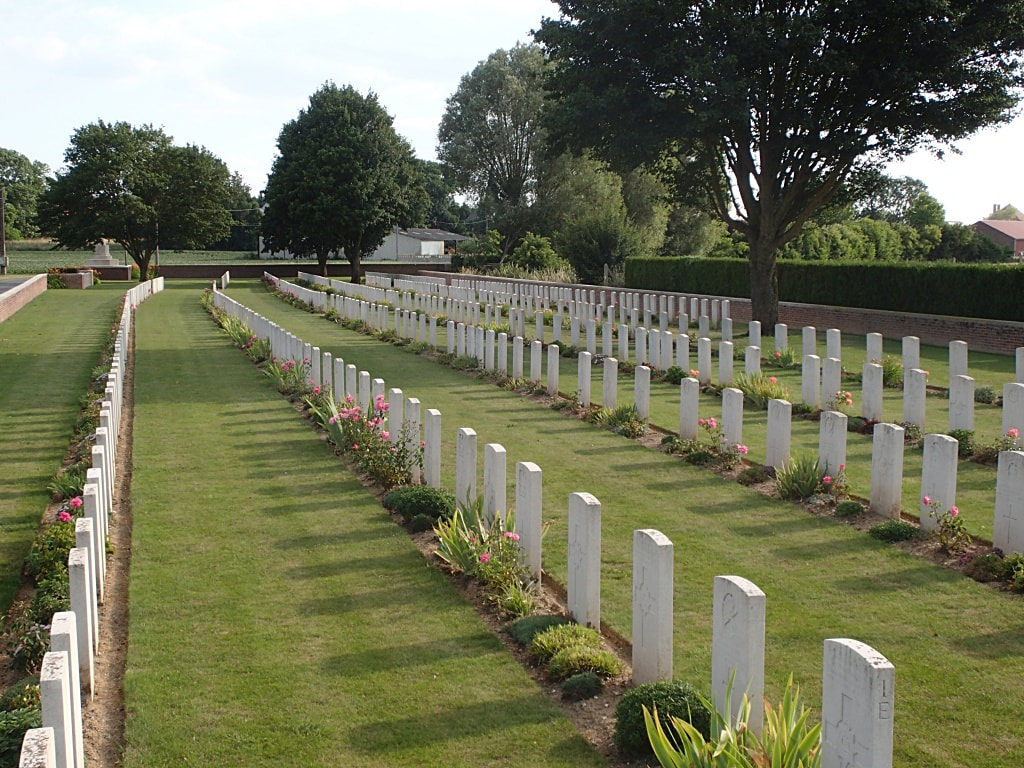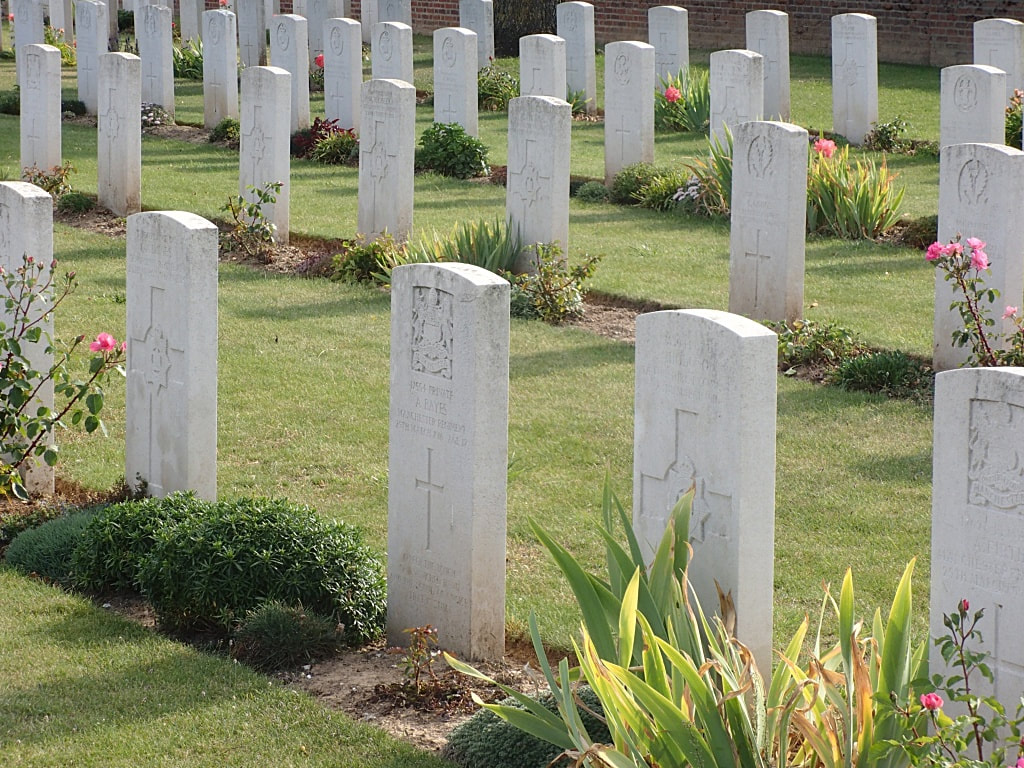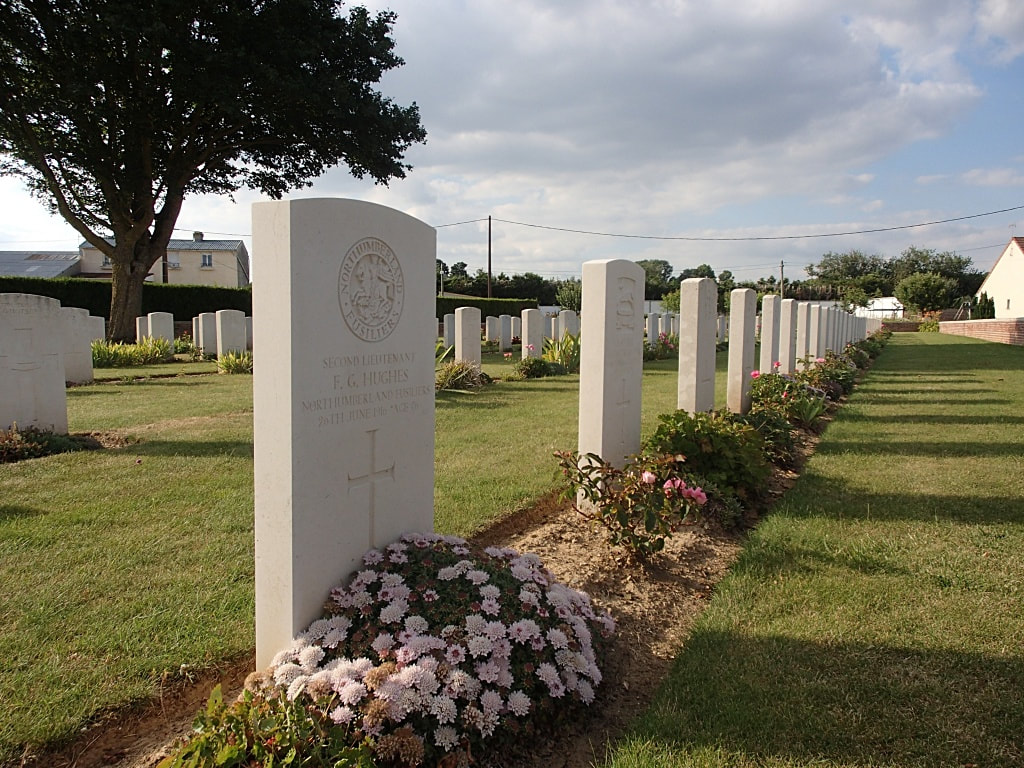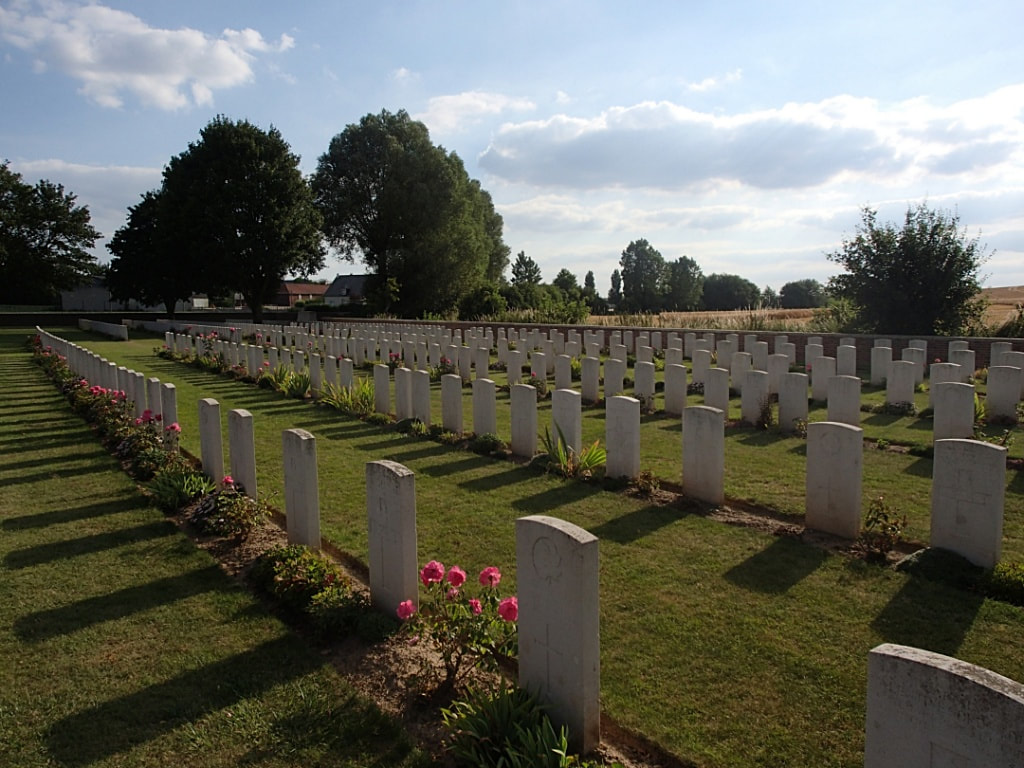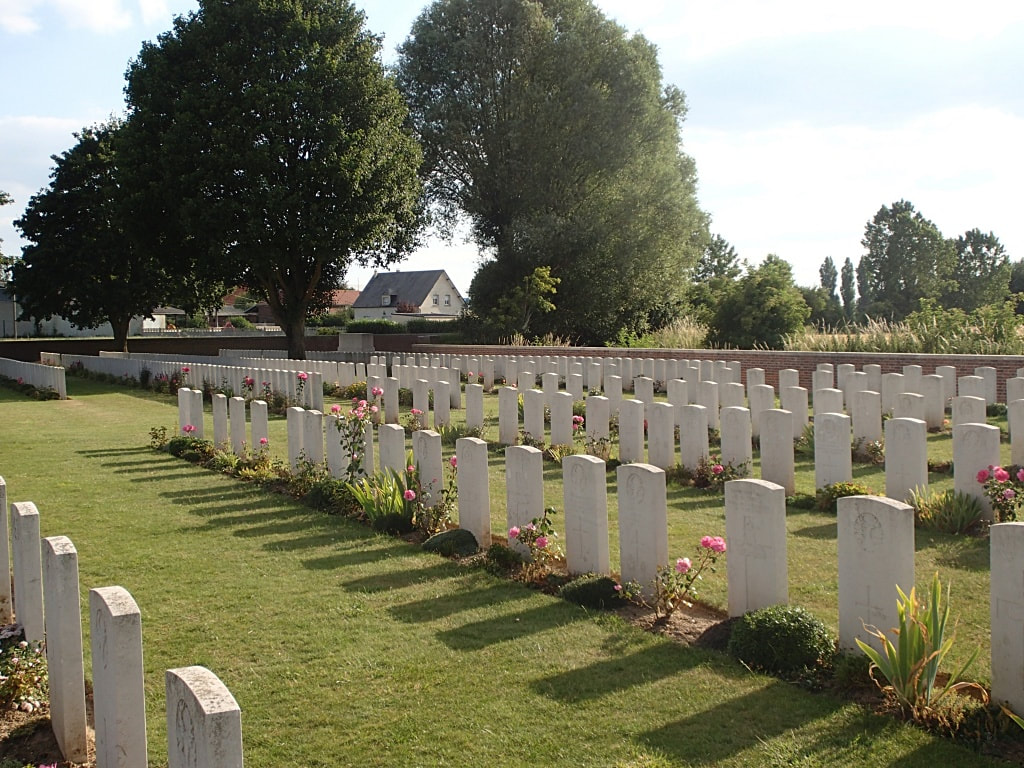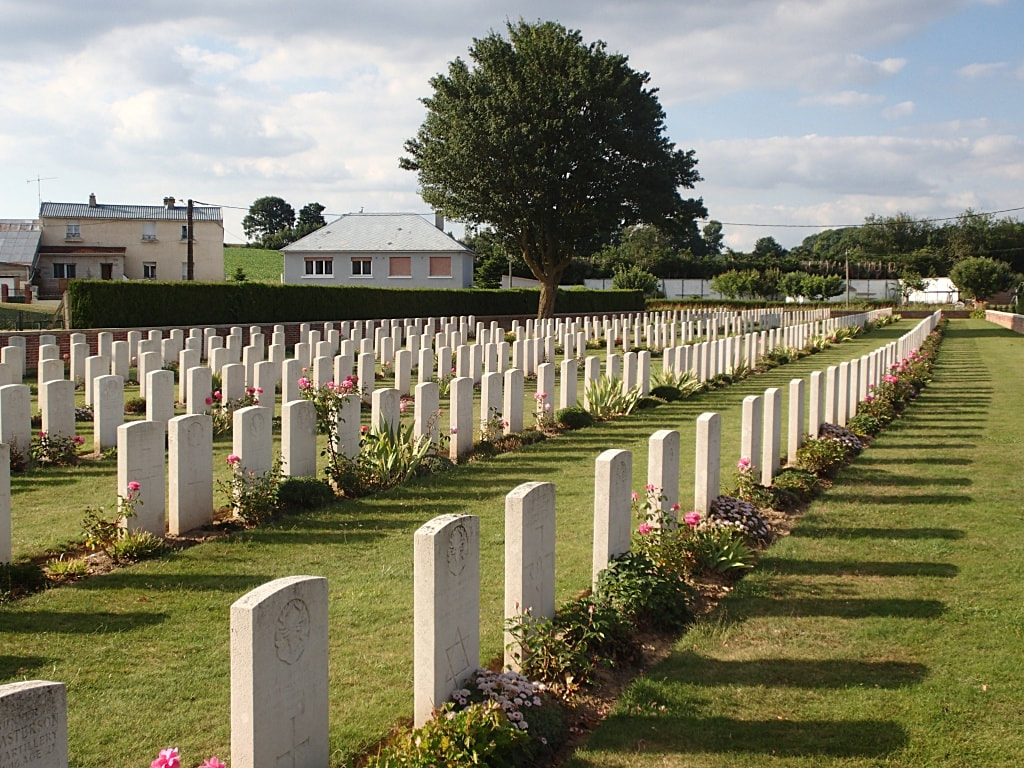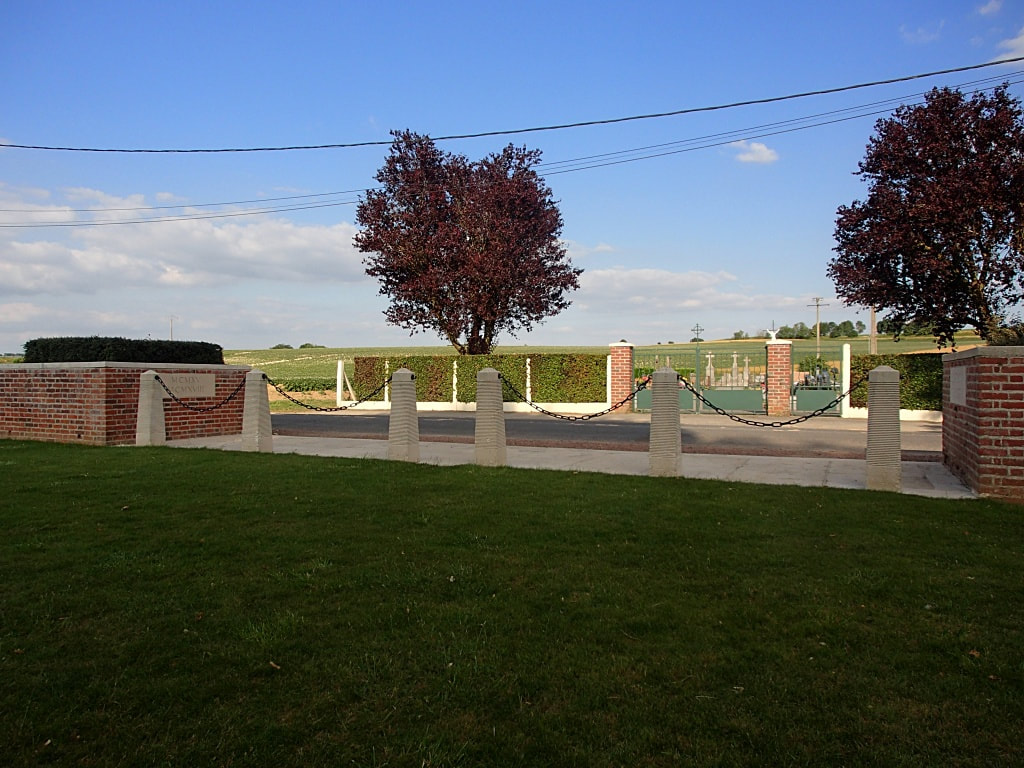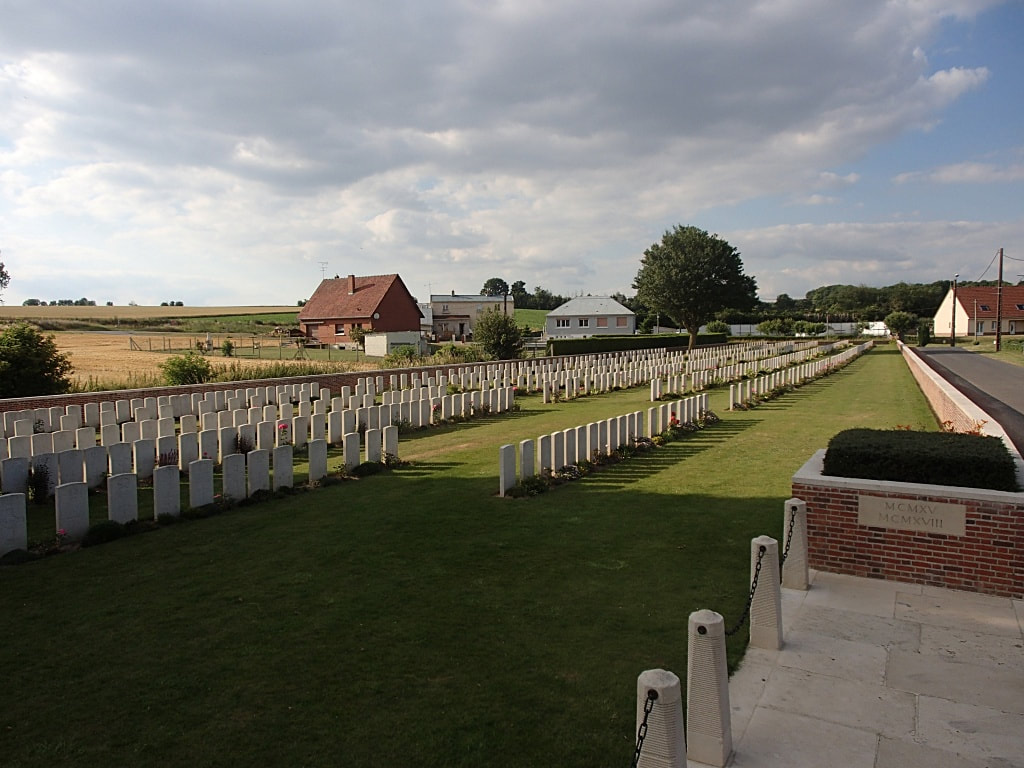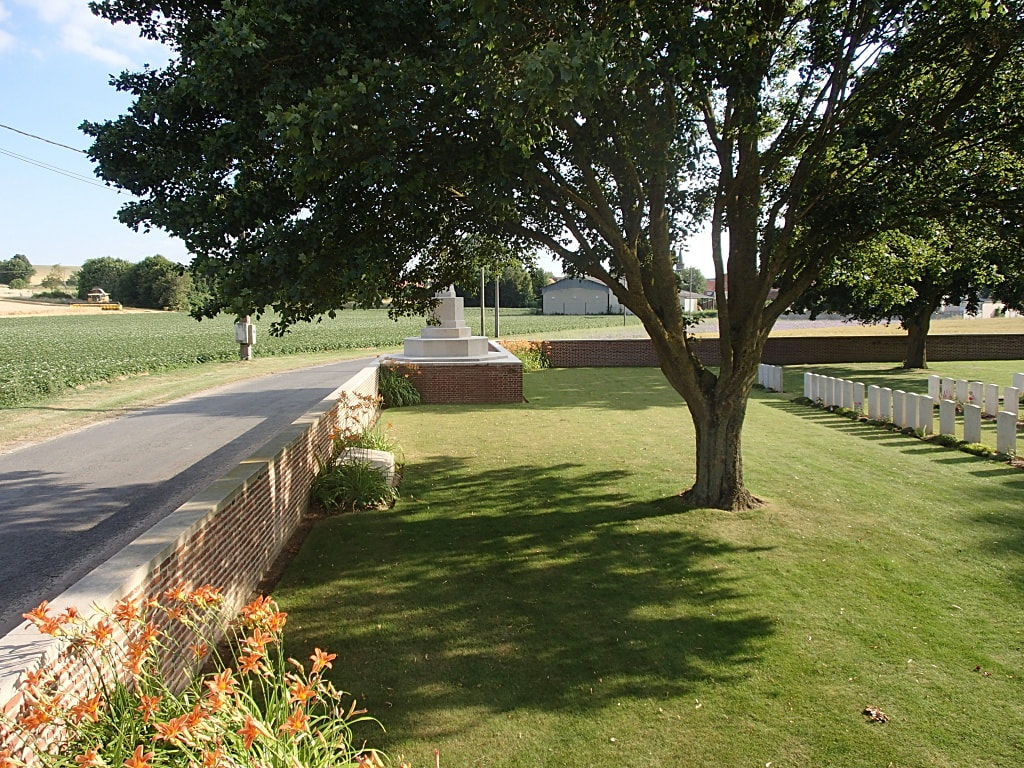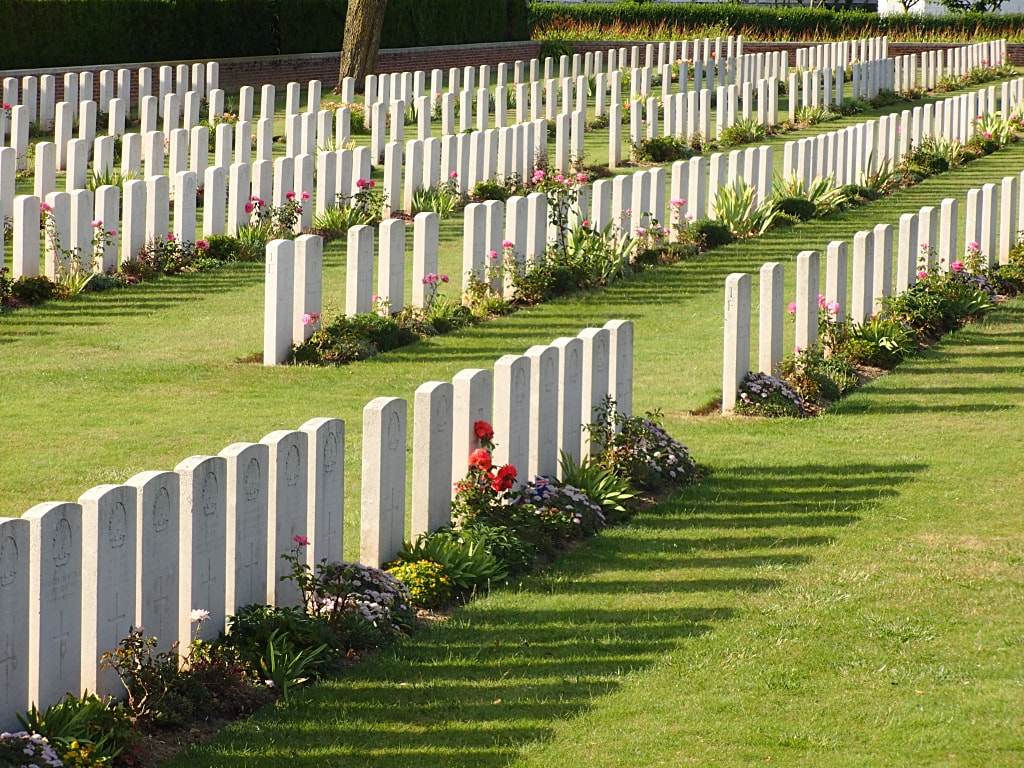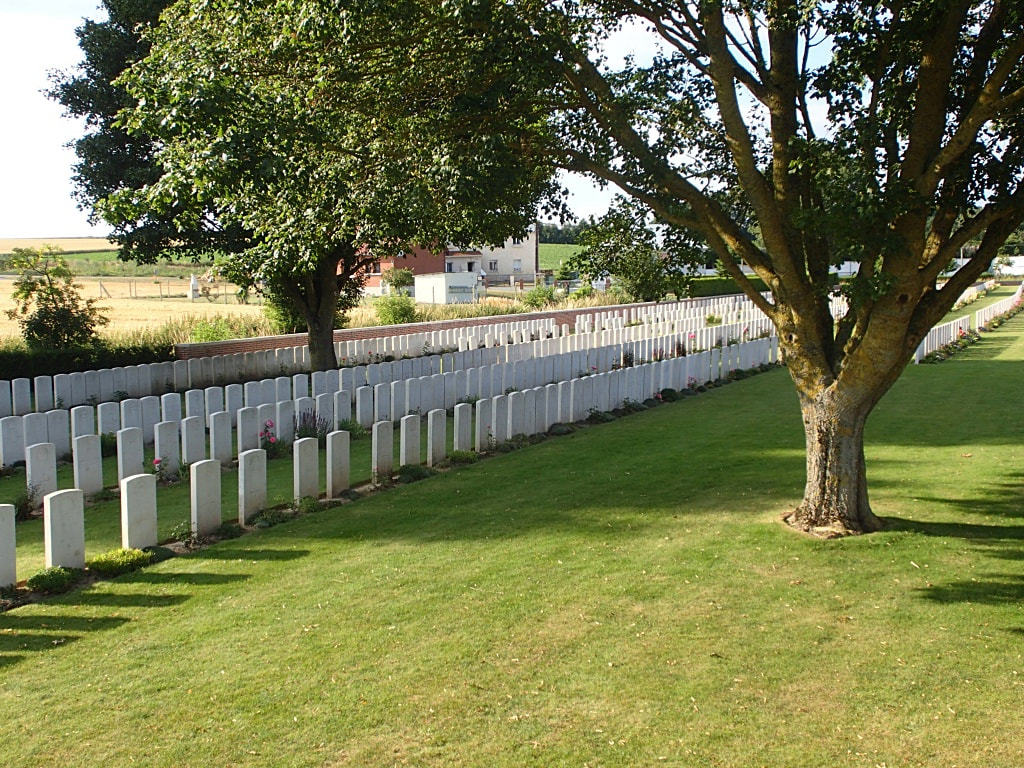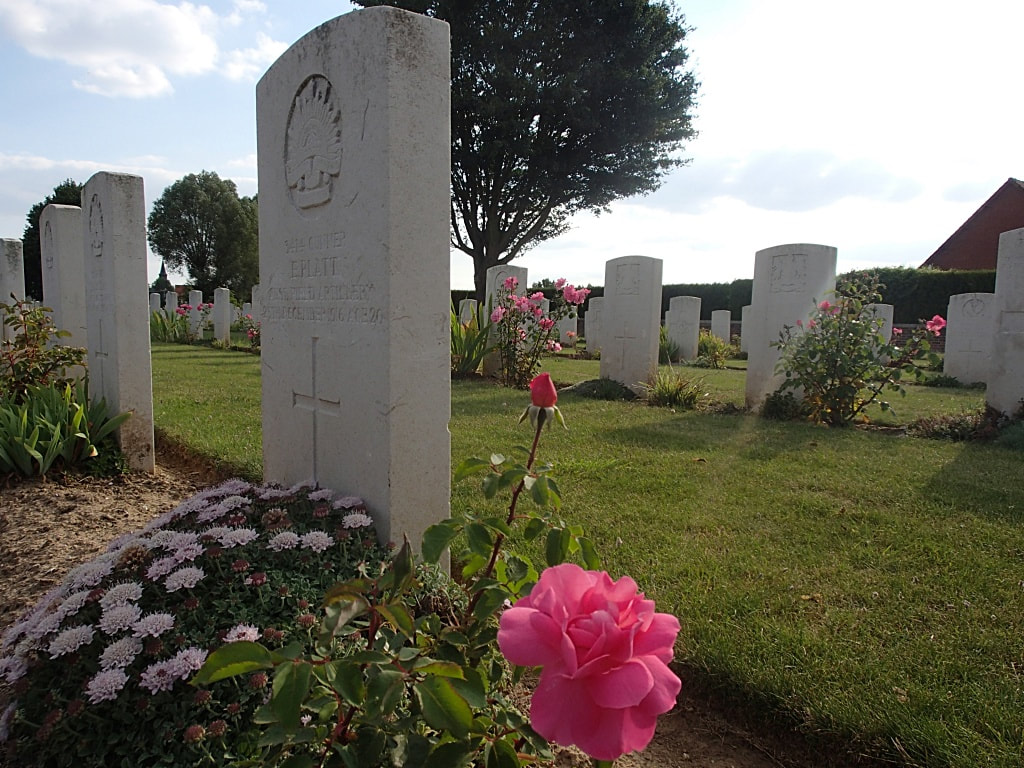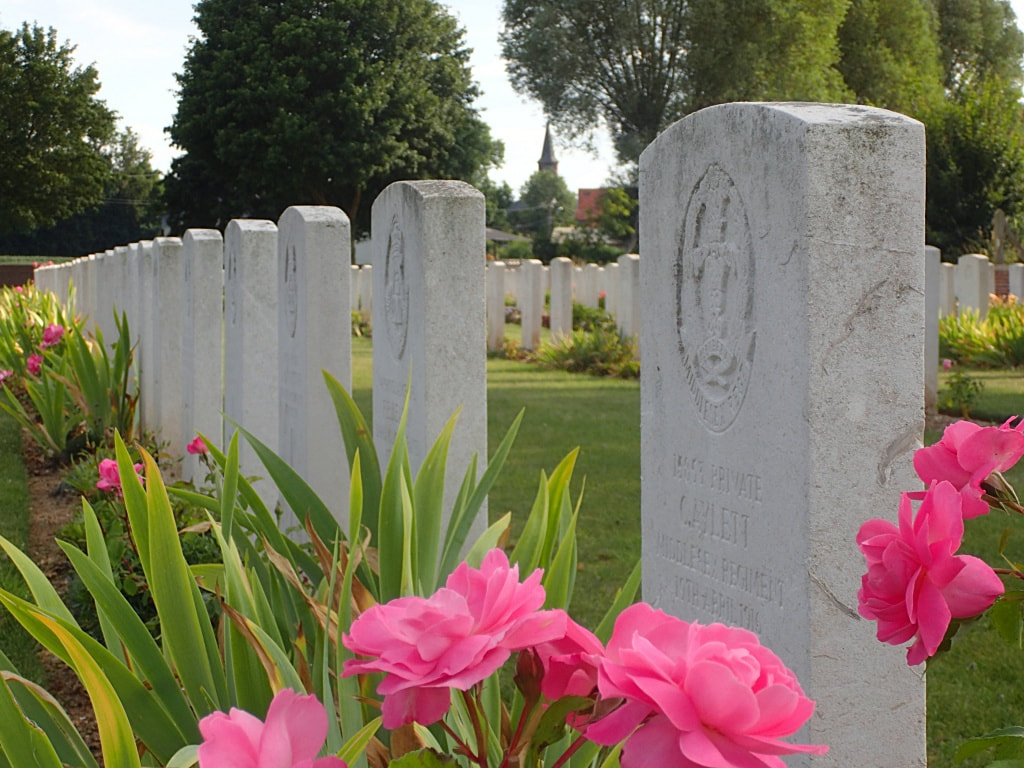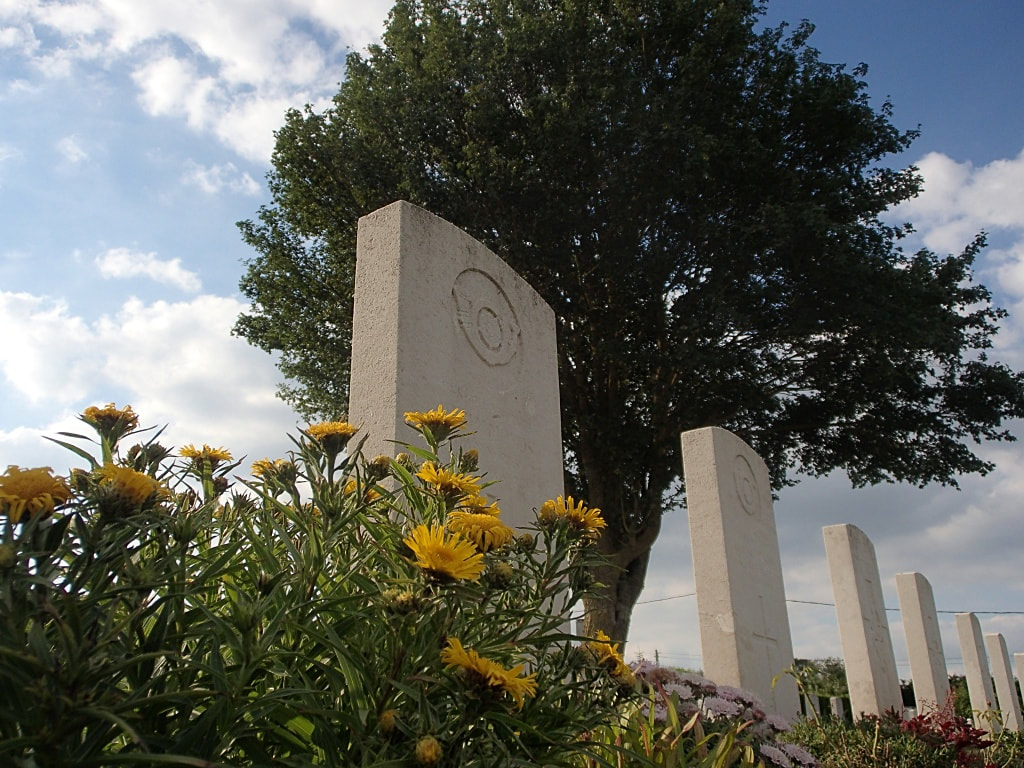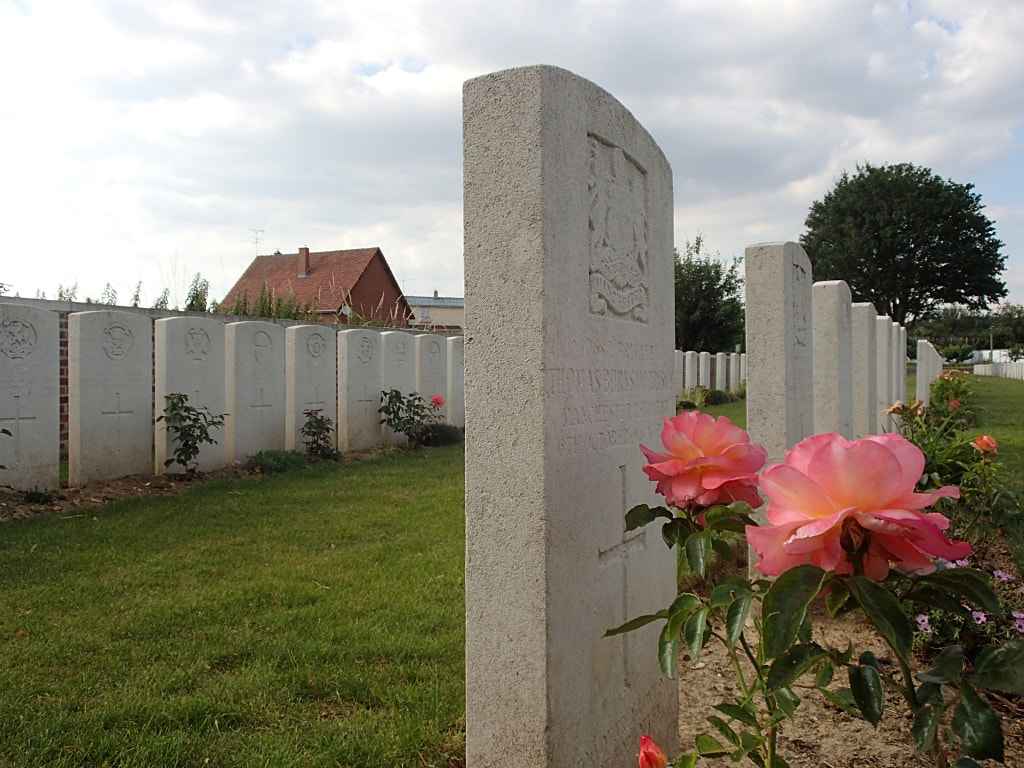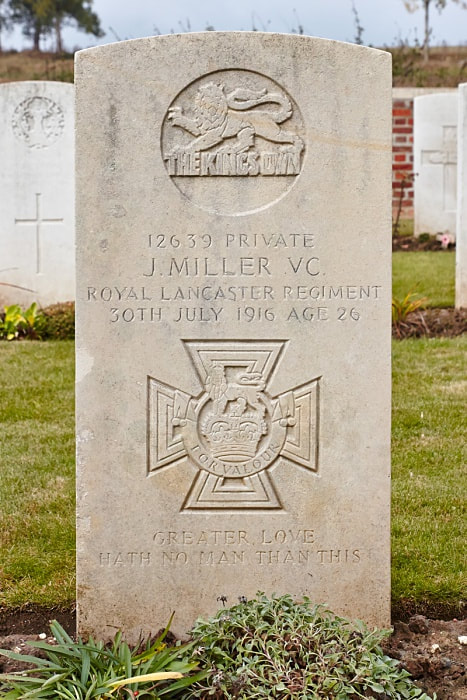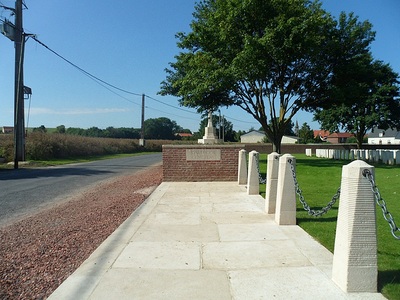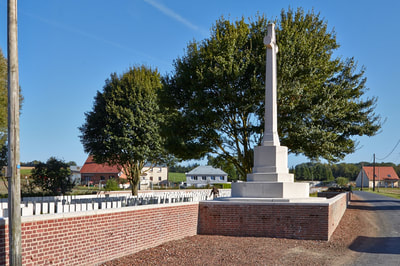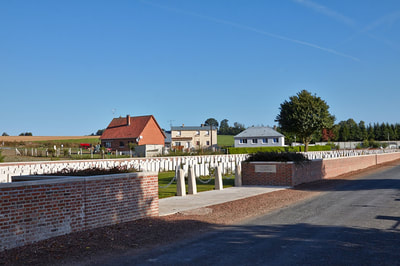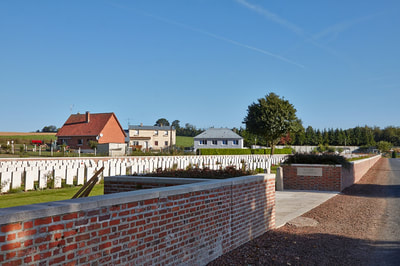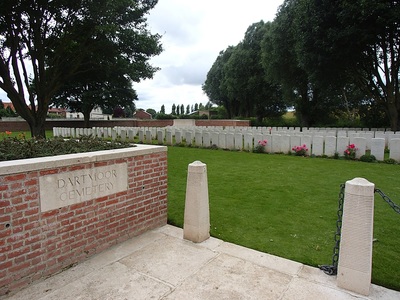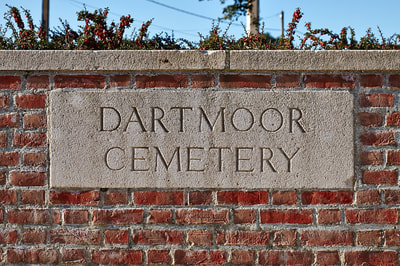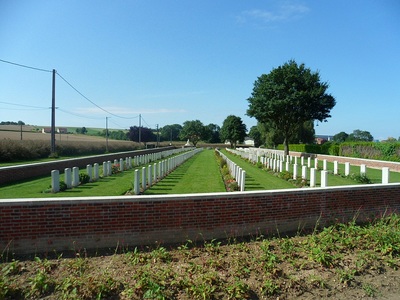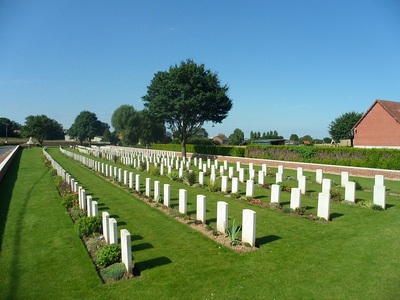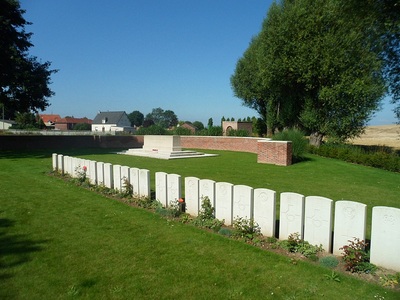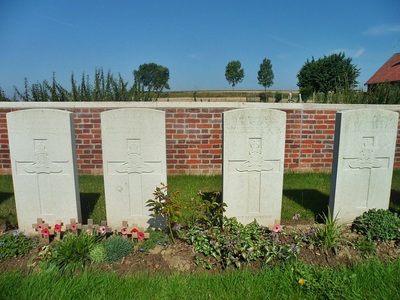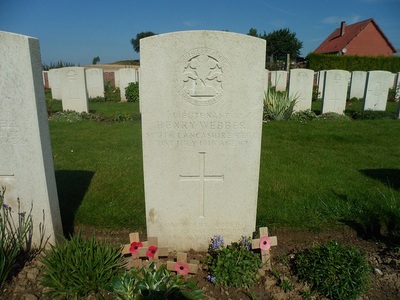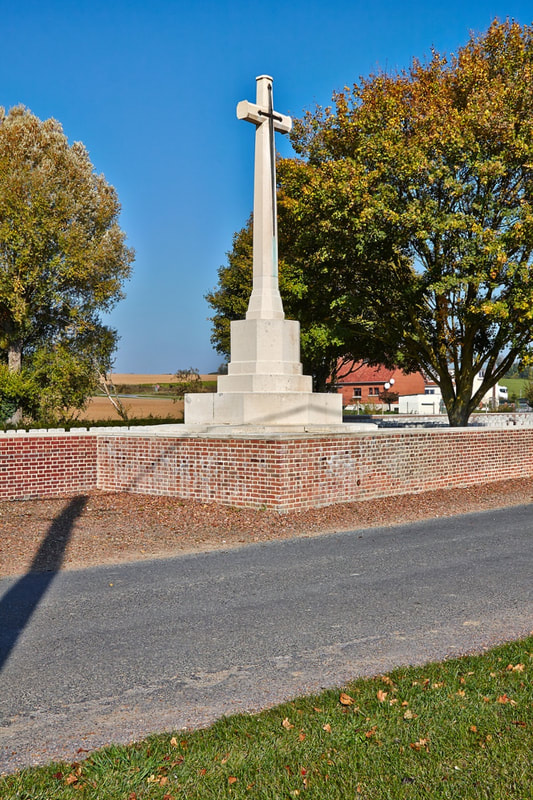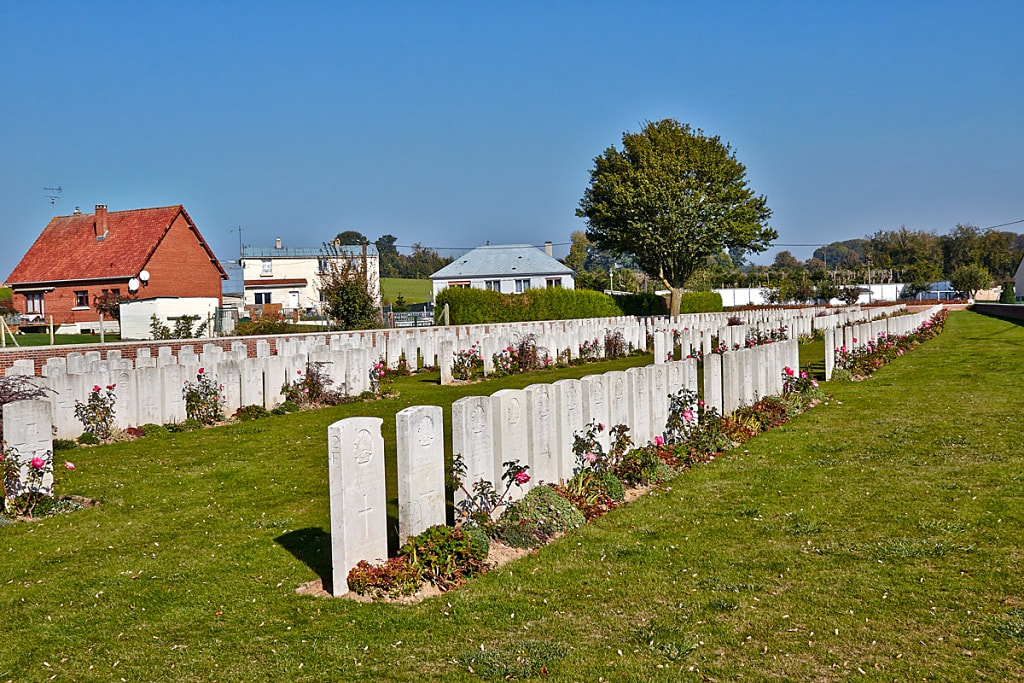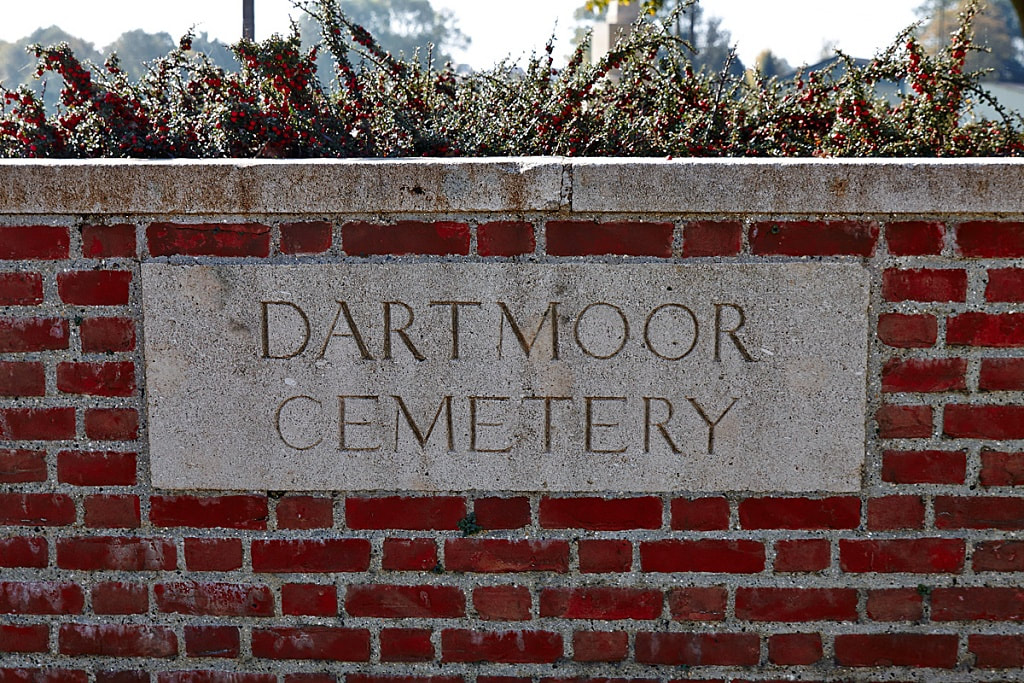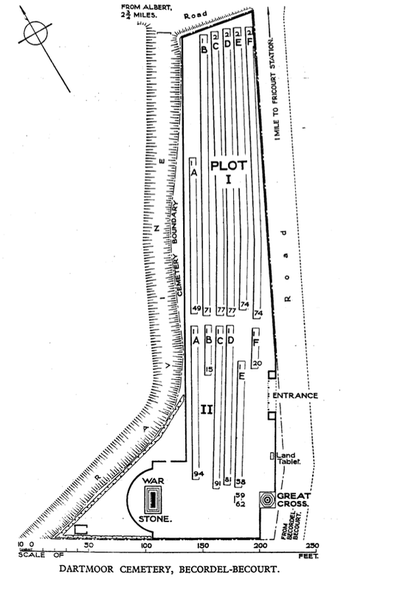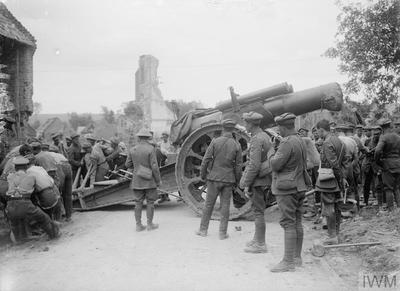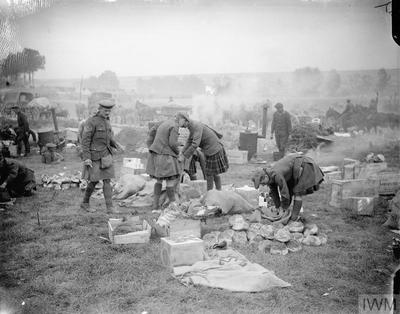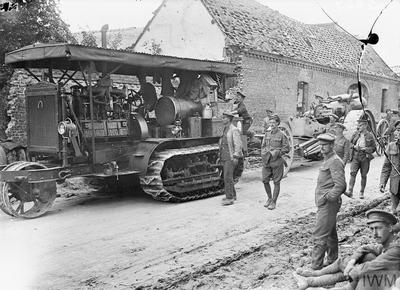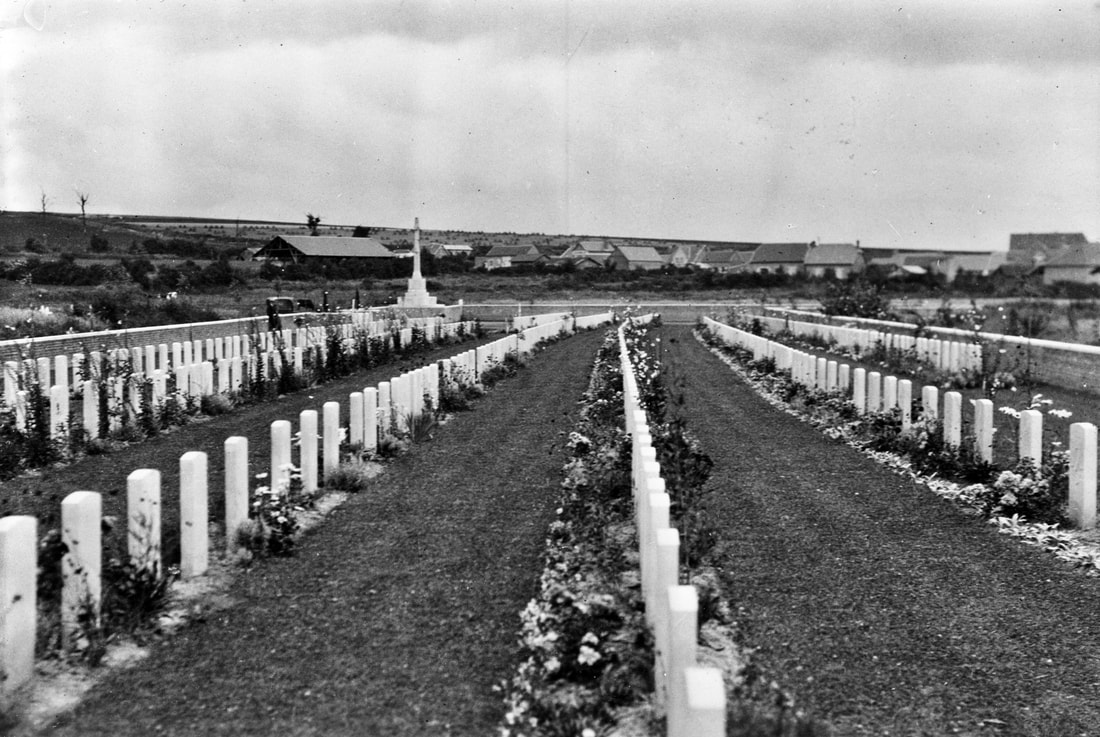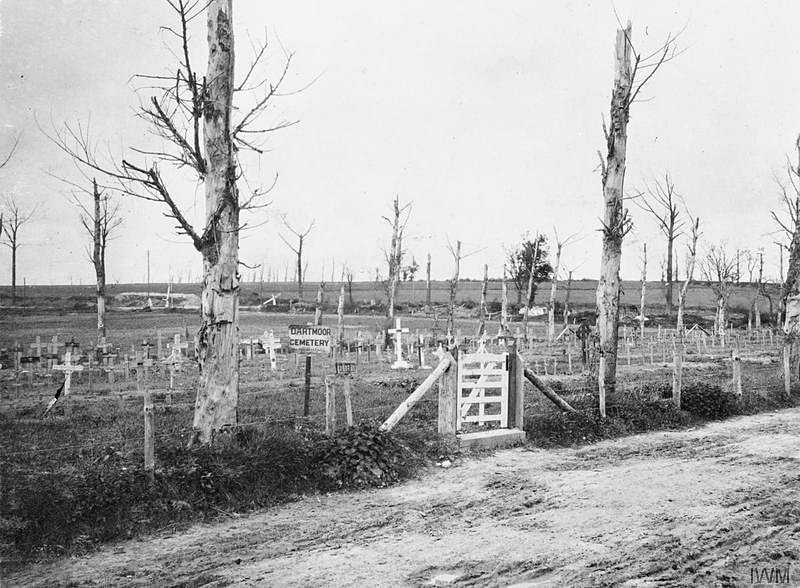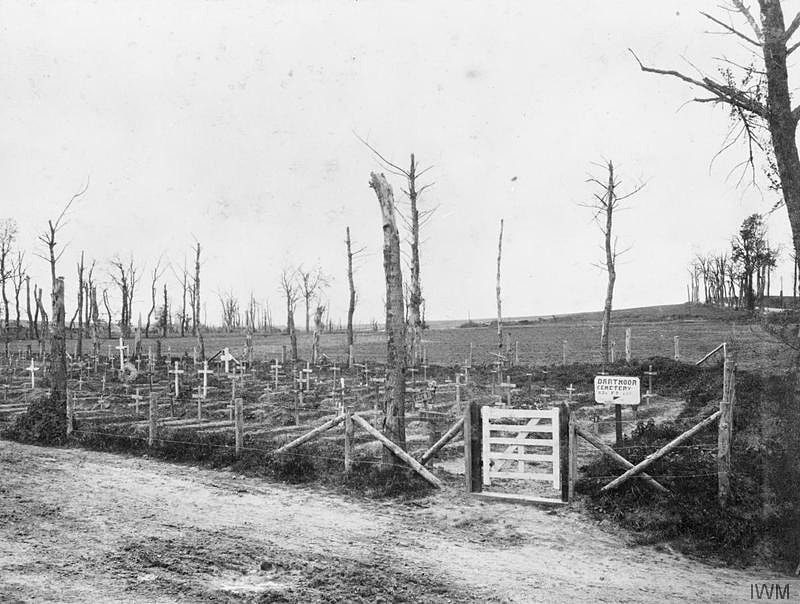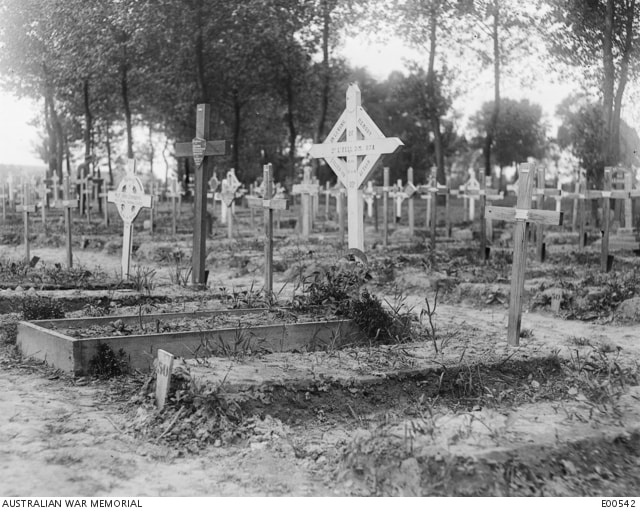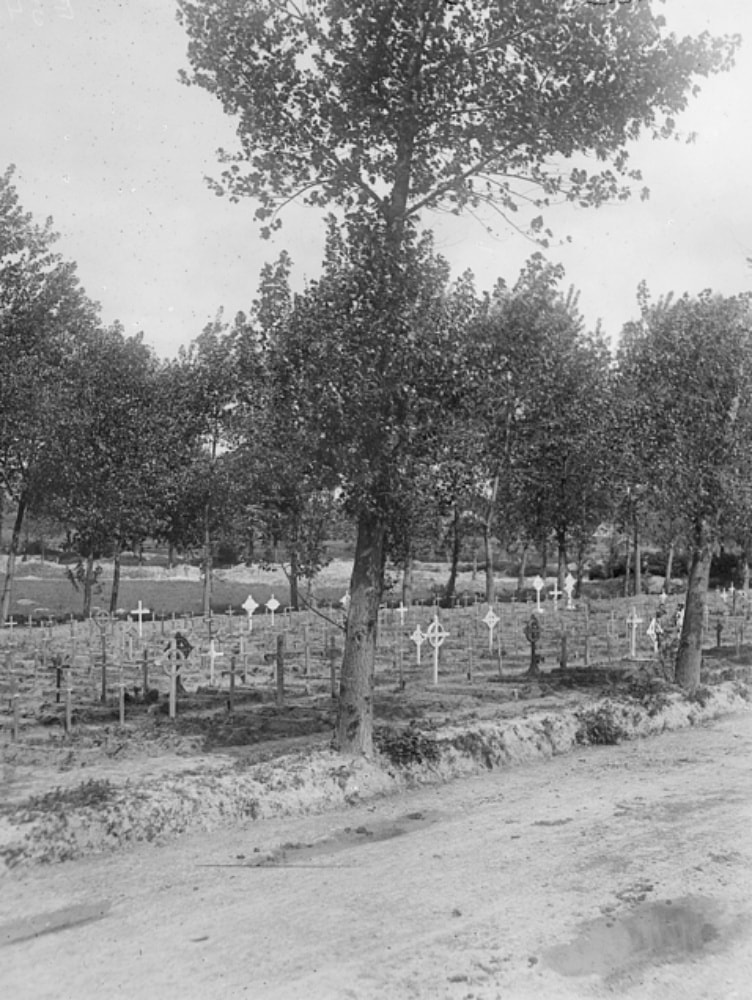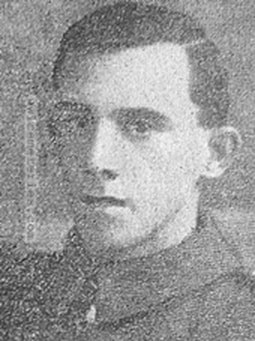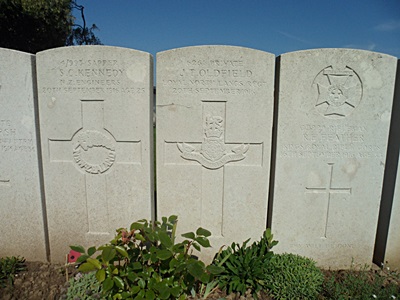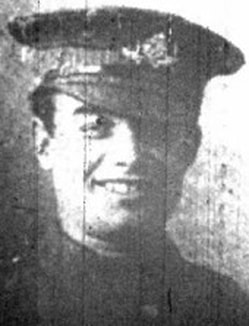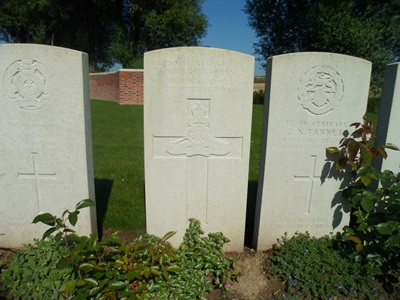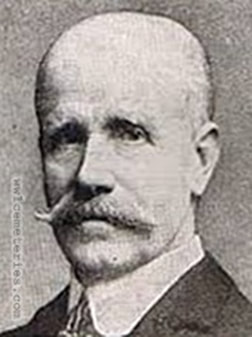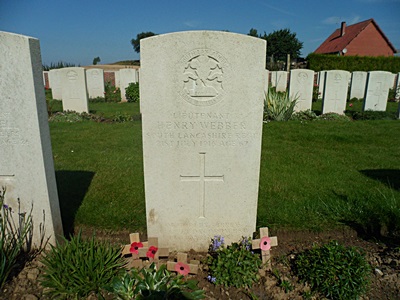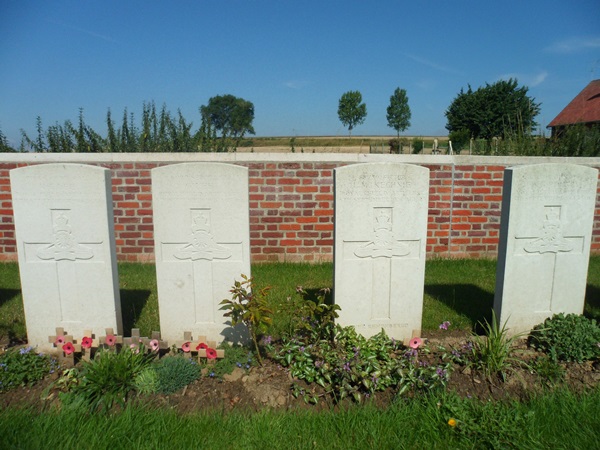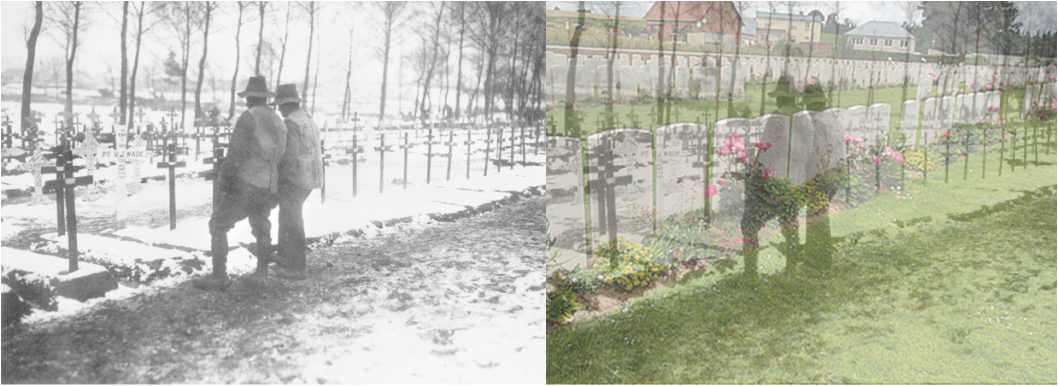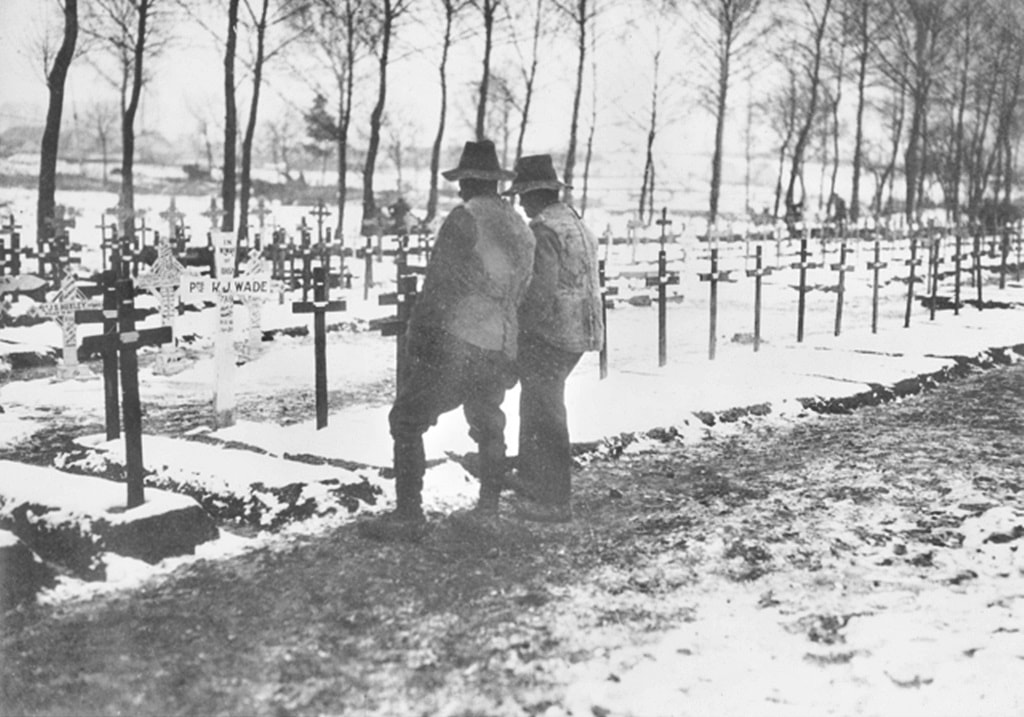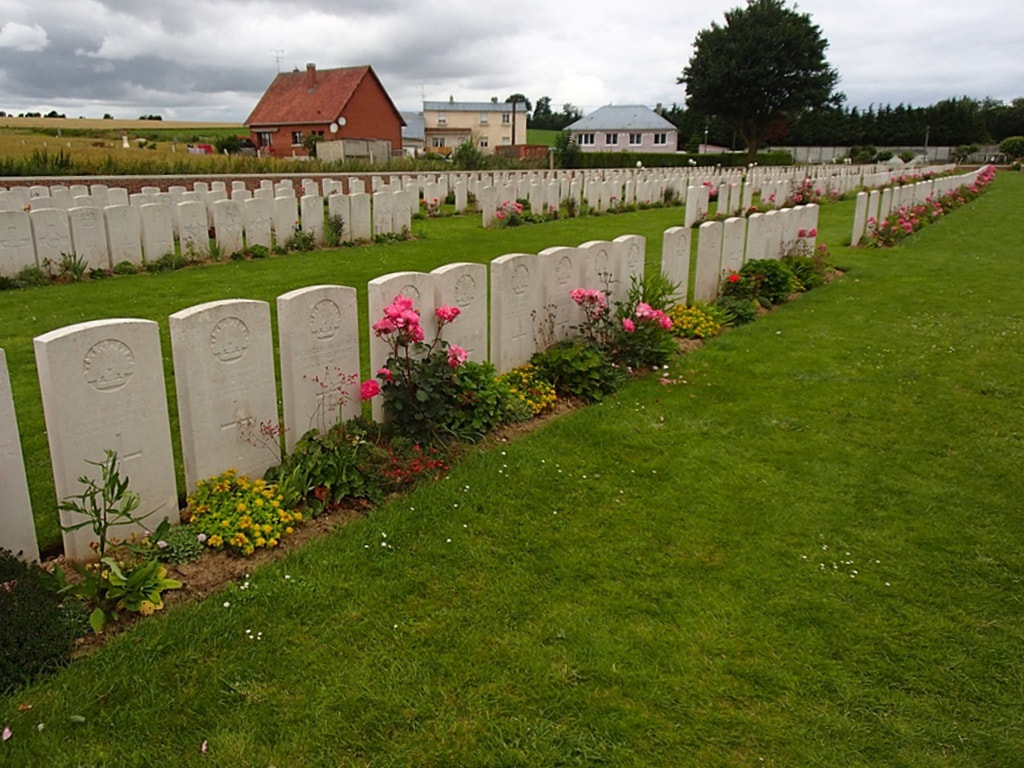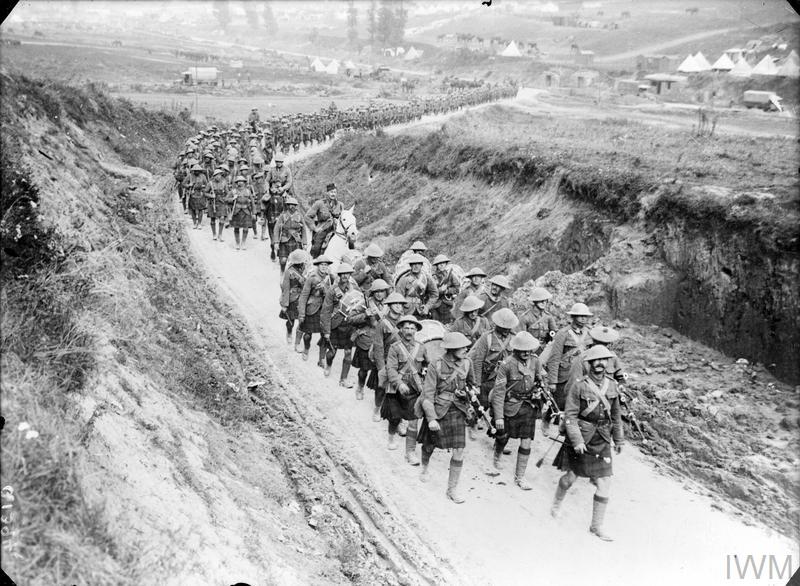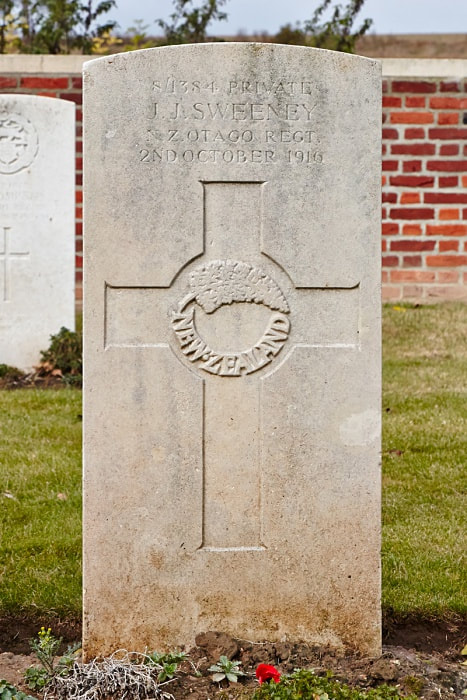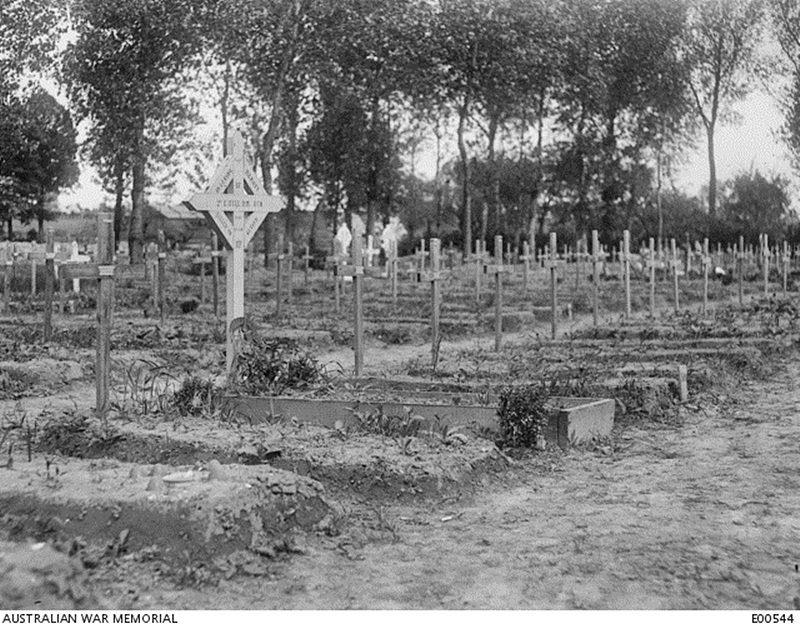DARTMOOR CEMETERY
Bécordel-Bécourt
Somme
France
GPS Coordinates - Latitude: 49.99165, Longitude: 2.68817
Location Information
Becordel-Becourt is a village about 2.5 kilometres south-east of Albert.
From the D938 (Albert-Peronne) take the road C2 (Becourt-Becordel). The Cemetery is immediately north of the village on the road to Becourt opposite the Communal Cemetery.
Historical Information
Dartmoor Cemetery was begun (as Becordel-Becourt Military Cemetery) in August 1915 and was used by the battalions holding that part of the line; its name was changed in May 1916 at the request of the 8th and 9th Battalions of the Devonshire Regiment. In September 1916, the XV Corps Main Dressing Station was established in the neighbourhood, but throughout 1917, the cemetery was scarcely used. It passed into German hands on 26 March 1918, but was retaken on 24 August by the 12th Division. There are five burials of August 1918, in Plot II, Row E.
In adjoining graves in Plot I, Row A, are buried a father and son, who served in the same artillery battery, and were killed in action on the same day.
Dartmoor Cemetery contains 768 Commonwealth burials of the First World War.
Total Burials: 768.
Identified Casualties: United Kingdon 629, Australia 70, New Zealand 59, Canada 4, India 1. Total 763.
The cemetery was designed by Sir Edwin Lutyens
Dedications
4/993 Sapper Samuel Clarence Kennedy, New Zealand Engineers, 20th September 1916, aged 25., Plot II. C. 34. Son of Samuel and Sarah Kennedy, of Christchurch, New Zealand.
"An ANZAC soldier who gave his life in a far away country so we might have life and freedom for generations to come".
Proudly dedicated by his great nephew Raoul Collings of Auckland, New Zealand.
15434 Private Alfred Walter Smith, 1st Bn. Lincolnshire Regiment, 25th May 1916, aged 18. Son of Divers & Emily Smith, 19 Wellington Terrace, Walsoken, Wisbech, Cambridgeshire.
Remembered by Susan Kitchen
Becordel-Becourt is a village about 2.5 kilometres south-east of Albert.
From the D938 (Albert-Peronne) take the road C2 (Becourt-Becordel). The Cemetery is immediately north of the village on the road to Becourt opposite the Communal Cemetery.
Historical Information
Dartmoor Cemetery was begun (as Becordel-Becourt Military Cemetery) in August 1915 and was used by the battalions holding that part of the line; its name was changed in May 1916 at the request of the 8th and 9th Battalions of the Devonshire Regiment. In September 1916, the XV Corps Main Dressing Station was established in the neighbourhood, but throughout 1917, the cemetery was scarcely used. It passed into German hands on 26 March 1918, but was retaken on 24 August by the 12th Division. There are five burials of August 1918, in Plot II, Row E.
In adjoining graves in Plot I, Row A, are buried a father and son, who served in the same artillery battery, and were killed in action on the same day.
Dartmoor Cemetery contains 768 Commonwealth burials of the First World War.
Total Burials: 768.
Identified Casualties: United Kingdon 629, Australia 70, New Zealand 59, Canada 4, India 1. Total 763.
The cemetery was designed by Sir Edwin Lutyens
Dedications
4/993 Sapper Samuel Clarence Kennedy, New Zealand Engineers, 20th September 1916, aged 25., Plot II. C. 34. Son of Samuel and Sarah Kennedy, of Christchurch, New Zealand.
"An ANZAC soldier who gave his life in a far away country so we might have life and freedom for generations to come".
Proudly dedicated by his great nephew Raoul Collings of Auckland, New Zealand.
15434 Private Alfred Walter Smith, 1st Bn. Lincolnshire Regiment, 25th May 1916, aged 18. Son of Divers & Emily Smith, 19 Wellington Terrace, Walsoken, Wisbech, Cambridgeshire.
Remembered by Susan Kitchen
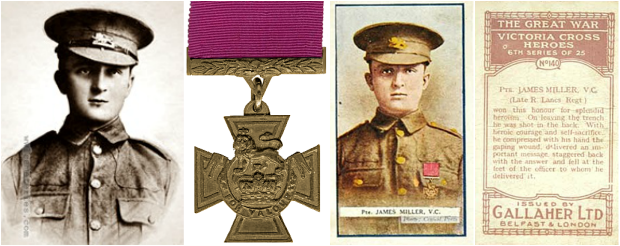
12639 Private James Miller, V. C.
7th Bn. King's Own (Royal Lancaster Regiment), died of wounds 30th July 1916. Plot I. C. 64.
Citation: An extract from "The London Gazette," No. 29740, dated 8th Sept., 1916, records the following:-"For most conspicuous bravery. His Battalion was consolidating a position after its capture by assault. Private Miller was ordered to take an important message under heavy shell and rifle fire and to bring back a reply at all costs. He was compelled to cross the open, and on leaving the trench was shot almost immediately in the back, the bullet coming out through his abdomen. In spite of this, with heroic courage and self-sacrifice, he compressed with his hand the gaping wound in his abdomen, delivered his message, staggered back with the answer and fell at the feet of the officer to whom he delivered it. He gave his life with a supreme devotion to duty."
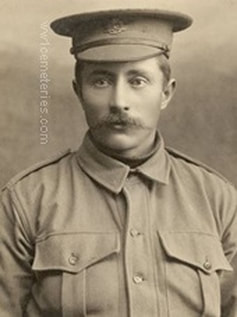
1518 Corporal
Robert John Bickford
21st Bn. Australian Infantry, A. I. F.
12th January 1917, aged 32.
Plot I. F. 2.
Son of Robert George and Hannah Jane Bickford, of Ravenswood, Victoria, Australia.
A labourer from Bendigo, Victoria, enlisted on 8 April 1915 and embarked from Melbourne on 28 June aboard HMAT Berrima (A35). He died of wounds in France on 12 January 1917. He had three brothers who also served in the AIF:; 1519 Pte Edward Bickford enlisted with Robert in the same unit and was killed in action at Pozieres on 26 August 1916 aged 27, he is commemorated on the Villers-Bretonneux Memorial. 815 Cpl William Bickford, 14th Battalion was killed in action in France on 11 April 1917 aged 25 and is buried in Queant Road Cemetery and their youngest brother, 716 Lance Corporal Nicholas Bickford, 6th Battalion who enlisted aged 19 on 7 January 1915, served at Gallipoli, in France and Belgium, and returned to Australia in 1919.
Robert John Bickford
21st Bn. Australian Infantry, A. I. F.
12th January 1917, aged 32.
Plot I. F. 2.
Son of Robert George and Hannah Jane Bickford, of Ravenswood, Victoria, Australia.
A labourer from Bendigo, Victoria, enlisted on 8 April 1915 and embarked from Melbourne on 28 June aboard HMAT Berrima (A35). He died of wounds in France on 12 January 1917. He had three brothers who also served in the AIF:; 1519 Pte Edward Bickford enlisted with Robert in the same unit and was killed in action at Pozieres on 26 August 1916 aged 27, he is commemorated on the Villers-Bretonneux Memorial. 815 Cpl William Bickford, 14th Battalion was killed in action in France on 11 April 1917 aged 25 and is buried in Queant Road Cemetery and their youngest brother, 716 Lance Corporal Nicholas Bickford, 6th Battalion who enlisted aged 19 on 7 January 1915, served at Gallipoli, in France and Belgium, and returned to Australia in 1919.
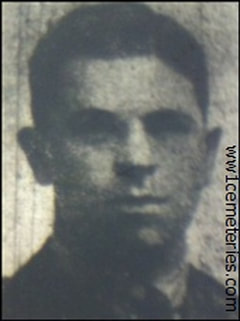
Second Lieutenant
Arthur Cecil Colmer
"A" Battery, 96th Brigade, Royal Field Artillery
1st July 1916, aged 23.
Plot I. F. 44.
Son of Arthur May Colmer and Annie Letitia Colmer, of Restormel House, Southwood Avenue, Bournemouth. Native of Liskeard, Cornwall.
Arthur Cecil Colmer
"A" Battery, 96th Brigade, Royal Field Artillery
1st July 1916, aged 23.
Plot I. F. 44.
Son of Arthur May Colmer and Annie Letitia Colmer, of Restormel House, Southwood Avenue, Bournemouth. Native of Liskeard, Cornwall.
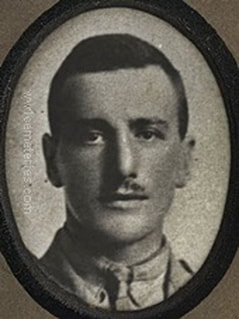
Lieutenant
Richard Hampden Guthrie
27th Bn. Australian Infantry, A. I. F.
6th November 1916, aged 26.
Plot II. E. 45.
Son of Walter Gibson Guthrie and Violet Mary Guthrie, of "Heatherwood," Heathdene Rd., Wallington, Surrey, England.
A 24 year old shipping clerk when he enlisted on 11 January 1915. He was promoted to Lieutenant on 26 May 1915 and joined the 27th Battalion at Gallipoli. After Gallipoli, the 27th Battalion returned to Egypt, and then proceeded to France as part of the 2nd Australian Division. The 27th Battalion entered the front-line trenches for the first time on 7 April 1916 and took part in its first major battle at Pozières between 28 July and 5 August. After a spell in a quieter sector of the front in Belgium, the 2nd Division returned to the south in October 1916. Lt Guthrie was wounded in action at Flers, France, on 5 November 1916 and died on 6 November 1916 at 1st Anzac Medical Dressing Station, France.
Richard Hampden Guthrie
27th Bn. Australian Infantry, A. I. F.
6th November 1916, aged 26.
Plot II. E. 45.
Son of Walter Gibson Guthrie and Violet Mary Guthrie, of "Heatherwood," Heathdene Rd., Wallington, Surrey, England.
A 24 year old shipping clerk when he enlisted on 11 January 1915. He was promoted to Lieutenant on 26 May 1915 and joined the 27th Battalion at Gallipoli. After Gallipoli, the 27th Battalion returned to Egypt, and then proceeded to France as part of the 2nd Australian Division. The 27th Battalion entered the front-line trenches for the first time on 7 April 1916 and took part in its first major battle at Pozières between 28 July and 5 August. After a spell in a quieter sector of the front in Belgium, the 2nd Division returned to the south in October 1916. Lt Guthrie was wounded in action at Flers, France, on 5 November 1916 and died on 6 November 1916 at 1st Anzac Medical Dressing Station, France.
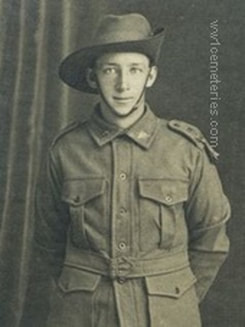
2415 Private
John William Hardy
19th Bn. Australian Infantry, A. I. F.
14th November 1916, aged 26.
Plot II. F. 10.
Son of Walter Joseph and Ellen Mary Hardy, of Hooper St., Randwick, New South Wales Native of Brisbane, Queensland.
From Brisbane, Qld. A compositer prior to enlistment he embarked from Sydney, NSW, with the 5th Reinforcements on board HMAT Themistocles (A32) on 5 October 1915. Pte Hardy died of wounds received at Flers, France on 14 November 1916, he was 26 years of age.
John William Hardy
19th Bn. Australian Infantry, A. I. F.
14th November 1916, aged 26.
Plot II. F. 10.
Son of Walter Joseph and Ellen Mary Hardy, of Hooper St., Randwick, New South Wales Native of Brisbane, Queensland.
From Brisbane, Qld. A compositer prior to enlistment he embarked from Sydney, NSW, with the 5th Reinforcements on board HMAT Themistocles (A32) on 5 October 1915. Pte Hardy died of wounds received at Flers, France on 14 November 1916, he was 26 years of age.
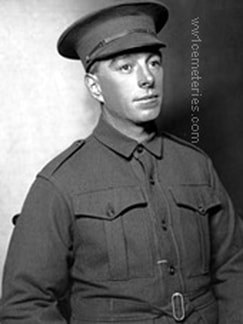
2928 Lance Corporal
Luke Francis Harrington
59th Bn. Australian Infantry, A. I. F.
13th February 1917, aged 32.
Plot I. A. 3.
Son of Luke Francis and Jane Harrington. Native of Kyneton, Victoria, Australia.
From Kyneton, Vic, aged 35. Pte Harrington enlisted on 12 July 1915 and embarked from Melbourne aboard HMAT Star of Victoria on 10 September 1915. He was Mentioned in Despatches (MID) by General Sir Douglas Haig GCB for'...distinguished and gallant services and devotion to duty', on 4 January 1917. He transferred to the 59th Battalion and died of accidental injuries (burns) on 13 February 1917 at Fricourt, France.
Luke Francis Harrington
59th Bn. Australian Infantry, A. I. F.
13th February 1917, aged 32.
Plot I. A. 3.
Son of Luke Francis and Jane Harrington. Native of Kyneton, Victoria, Australia.
From Kyneton, Vic, aged 35. Pte Harrington enlisted on 12 July 1915 and embarked from Melbourne aboard HMAT Star of Victoria on 10 September 1915. He was Mentioned in Despatches (MID) by General Sir Douglas Haig GCB for'...distinguished and gallant services and devotion to duty', on 4 January 1917. He transferred to the 59th Battalion and died of accidental injuries (burns) on 13 February 1917 at Fricourt, France.
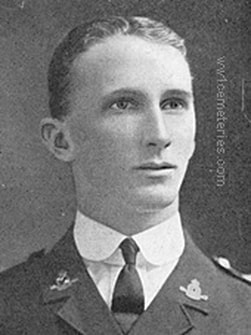
Captain
Edward William Jenkins
6th A. F. A. Bde. Australian Field Artillery
21st December 1916, aged 21.
Plot I. F. 17.
Son of Edward William and Beatrice Rosina Jenkins, of Shaw St., Camperdown, Victoria, Australia.
Prior to enlisting, he was a student at The Royal Military College. Canberra, ACT. He embarked from Melbourne aboard HMAT Wiltshire (A18) on 18 November 1915. On 21 December 1916, he was struck by a shell and killed in action at Needle Dump near Gueudecourt, France, aged 21.
Edward William Jenkins
6th A. F. A. Bde. Australian Field Artillery
21st December 1916, aged 21.
Plot I. F. 17.
Son of Edward William and Beatrice Rosina Jenkins, of Shaw St., Camperdown, Victoria, Australia.
Prior to enlisting, he was a student at The Royal Military College. Canberra, ACT. He embarked from Melbourne aboard HMAT Wiltshire (A18) on 18 November 1915. On 21 December 1916, he was struck by a shell and killed in action at Needle Dump near Gueudecourt, France, aged 21.
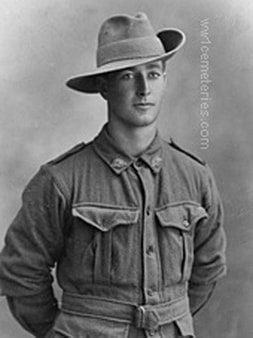
1050A Private
Albert Andrew Johnston
9th Bn. Australian Infantry, A. I. F.
25th December 1916, aged 25.
Plot I. F. 15.
Son of Charles and Amelia Anne Johnston.
Albert Andrew Johnston
9th Bn. Australian Infantry, A. I. F.
25th December 1916, aged 25.
Plot I. F. 15.
Son of Charles and Amelia Anne Johnston.
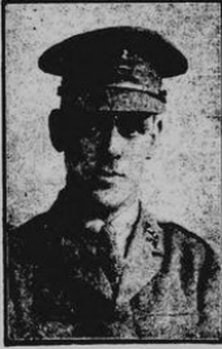
Lieutenant
Adrian Robson May
5th Bn. The King's (Liverpool Regiment)
8th September 1916, aged 19.
Plot I. A. 17.
Son of Thomas James and Fanny Blanche May, of "Eversley," Riversbank Rd., Heswall, Cheshire.
Adrian Robson May
5th Bn. The King's (Liverpool Regiment)
8th September 1916, aged 19.
Plot I. A. 17.
Son of Thomas James and Fanny Blanche May, of "Eversley," Riversbank Rd., Heswall, Cheshire.

View of the battlefield at La Boisselle in September 1916 showing the Cross erected to several members of the 34th Division, who were killed in action on 1st July, 1916. This Cross was 20 yard to the left of the roadway on the hill crest overlooking the giant mine crater, Becourt Wood, Sausage Valley and on to Fricourt, Mametz and Carnoy; since replaced by a permanent monument. © IWM (Q 1055)
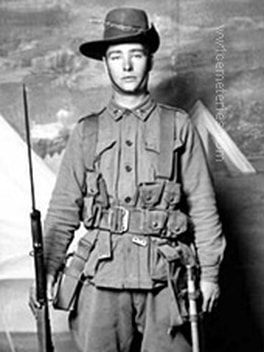
3164 Private
William John Thomas Weaver
6th Bn. Australian Infantry, A. I. F.
1st November 1916, aged 22.
Plot II. E. 33.
Son of John and Caroline Weaver, of Molesworth, Victoria, Australia. Native of Benalla, Victoria.
Pte Weaver enlisted on 19 June 1915 and embarked from Melbourne aboard HMAT Osterley on 29 September 1915. He died of wounds on 1 November 1916 in France.
William John Thomas Weaver
6th Bn. Australian Infantry, A. I. F.
1st November 1916, aged 22.
Plot II. E. 33.
Son of John and Caroline Weaver, of Molesworth, Victoria, Australia. Native of Benalla, Victoria.
Pte Weaver enlisted on 19 June 1915 and embarked from Melbourne aboard HMAT Osterley on 29 September 1915. He died of wounds on 1 November 1916 in France.
The WW1 soldier who went to war in his 60s
By Jasper Copping
The story of the oldest known British soldier to die in the First World War emerges, 100 years on from the conflict
With permission of The Daily Telegraph
In his poem, Wilfred Owen lamented the “doomed youth” who lost their lives in the slaughter of the First World War.
But it seems that the ultimate sacrifice was made not just by the young.
Almost a century on from the outbreak of the conflict, a tale has emerged of how a 67-year-old soldier became Britain’s oldest known combatant victim.
Henry Webber was far older than the maximum age to serve in the army, but had eventually succeeded in lobbying the authorities to allow him to join up. He had been motivated by a desire to serve with his three sons, who were all serving.
But in a twist of fate, all three were to survive the conflict, while Webber was to die on the Western Front.
His tale has emerged in response to a series of supplements, published by The Sunday Telegraph in advance of this summer’s centenary of the outbreak.
His great grandson, Paul Bellinger, also 67, from Woldingham, Surrey, responded to an appeal for readers’ stories.
Mr Bellinger, who was raised by his father in South Africa, only discovered the story himself, at the age of 59, when he found his mother had had two more children, in Britain.
Along with his newly-found step sister Ann, he has unravelled much of the story of their great grandfather, and has since visited his war grave in France.
Mr Bellinger, a producer for the American television show 60 Minutes, said: “What a resourceful individual he was. His is a fantastic story and to find out that I had that sort of history in my family was a great revelation.”
Webber was born in Tonbridge, Kent, in 1849, and was educated at Tonbridge School and Pembroke College Oxford, graduating in 1870.
Two years later, he joined the Stock Exchange - of which he was to remain a member for 42 years.
He became a member of the firm of Norman Morris and Co and 1874 he married the eldest daughter of Norman Morris, one of the firm’s senior partners.
The couple went on to have four sons and five daughters and settled in Horley. Webber became a very active member of local society, as one of the original members of Surrey County Council and the first chairman of the parish council.
He was also involved in the administration of a local hospital, became chairman of directors of the Horley Gas Company and served as a county magistrate, church warden and president of the local Boys Scouts Association.
A keen sportsman, he was an accomplished shot, a master of the Old Surrey and Burstow Hunt, a talented cricketer - scoring 200 runs aged 59 - a member of the MCC, and the first captain of Gatwick Golf Club.
After the outbreak of war, in August 1914, he tried to join his sons in uniform. He was repeatedly turned down, as he was more than 20 years over the age limit.
He first volunteered to serve 'in any capacity’ but when rebuffed he recruited a company of 'rough riders’ - fellow-horsemen like himself - and offered the unit complete to the army. Again, he was turned down.
But he persevered was eventually given a commission, on 26 July 1915. Whether this was in recognition of his persistence or because he lied about his age, is unclear.
After a brief training period at Park Royal, north west London, he was sent to France as a battalion transport officer.
He served with the 7th South Lancs battalion and was apparently accepted by its younger officers. It was said that many comrades were unaware of his true age, although his commanding officer apparently found that his own father and Webber had rowed together at Oxford in the same year, over half a century earlier.
His role involved helping in the build-up for the Somme offensive, which started on July 1st 1916. He and his unit were not involved in the initial attack, but took part in following actions, including the capture of La Boiselle on July 3rd 1916.
Two weeks later, on July 17th he wrote a letter to his old school: “Fifty one years ago I got my colours in the XI and last week 51 years ago was bowling against the old boys and looking on some of them as “sitters” and in the “sere and yellow leaf”.
“Yet here I am a Lieutenant in HM army having to salute three sons if I meet them out here, a Colonel and two Majors. I am 1st Line Transport Officer to this Battalion and we have been plumb in the centre of the picture during the last ten days and gained no end of “kudos” and also a very severe mauling.
“I am so far extraordinarily fit and well, though, when I tell you that for four consecutive days I was either on my feet or in the saddle for twenty one hours, out of twenty four, you will see that there is a bit of work attached to the job.”
Four days later, before the letter was received, he was dead. On July 21st the 7th Lancs moved up to relieve a battalion in the front line near Mametz Wood.
That night Henry Webber took supplies as usual with the battalion transport. Leaving his men to unload the horses, he went over to where the commanding officer was talking to a group of officers.
However, at that moment, the area - a mile or so east of Albert - came under attack and a shell landed nearby. Webber was among 12 men - and three horses - which had been hit, suffering a head wound. He, along with the others, was taken to a dressing station, but never regained consciousness and died that night, just over a month after his 67th birthday.
Following his death, his family received messages of sympathy from the King and Queen and the Army Council, which was unusual for a lieutenant and apparently a reflection of his age and eagerness to serve. His Commanding Officer wrote “He was so gallant and full of energy. We all had the greatest admiration and respect for him.”
He was also mentioned in Sir Douglas Haig’s despatches of the 4th of January 1917.
Within two years, his widow too had died, according to the family having been unable to recover from her husband’s death. The three sons all survived.
His eldest, NW (Tommy) Webber CMG DSO (& 9 Mentions in Despatches) rose to become a brigadier general and had a distinguished war career ending up as chief of staff to the commander of the Canadian Corps and was later managing director of the Army & Navy Stores group.
The other two were Maj H.H. Webber RGA and Major Leonard Morris Webber RFA.
But it seems that the ultimate sacrifice was made not just by the young.
Almost a century on from the outbreak of the conflict, a tale has emerged of how a 67-year-old soldier became Britain’s oldest known combatant victim.
Henry Webber was far older than the maximum age to serve in the army, but had eventually succeeded in lobbying the authorities to allow him to join up. He had been motivated by a desire to serve with his three sons, who were all serving.
But in a twist of fate, all three were to survive the conflict, while Webber was to die on the Western Front.
His tale has emerged in response to a series of supplements, published by The Sunday Telegraph in advance of this summer’s centenary of the outbreak.
His great grandson, Paul Bellinger, also 67, from Woldingham, Surrey, responded to an appeal for readers’ stories.
Mr Bellinger, who was raised by his father in South Africa, only discovered the story himself, at the age of 59, when he found his mother had had two more children, in Britain.
Along with his newly-found step sister Ann, he has unravelled much of the story of their great grandfather, and has since visited his war grave in France.
Mr Bellinger, a producer for the American television show 60 Minutes, said: “What a resourceful individual he was. His is a fantastic story and to find out that I had that sort of history in my family was a great revelation.”
Webber was born in Tonbridge, Kent, in 1849, and was educated at Tonbridge School and Pembroke College Oxford, graduating in 1870.
Two years later, he joined the Stock Exchange - of which he was to remain a member for 42 years.
He became a member of the firm of Norman Morris and Co and 1874 he married the eldest daughter of Norman Morris, one of the firm’s senior partners.
The couple went on to have four sons and five daughters and settled in Horley. Webber became a very active member of local society, as one of the original members of Surrey County Council and the first chairman of the parish council.
He was also involved in the administration of a local hospital, became chairman of directors of the Horley Gas Company and served as a county magistrate, church warden and president of the local Boys Scouts Association.
A keen sportsman, he was an accomplished shot, a master of the Old Surrey and Burstow Hunt, a talented cricketer - scoring 200 runs aged 59 - a member of the MCC, and the first captain of Gatwick Golf Club.
After the outbreak of war, in August 1914, he tried to join his sons in uniform. He was repeatedly turned down, as he was more than 20 years over the age limit.
He first volunteered to serve 'in any capacity’ but when rebuffed he recruited a company of 'rough riders’ - fellow-horsemen like himself - and offered the unit complete to the army. Again, he was turned down.
But he persevered was eventually given a commission, on 26 July 1915. Whether this was in recognition of his persistence or because he lied about his age, is unclear.
After a brief training period at Park Royal, north west London, he was sent to France as a battalion transport officer.
He served with the 7th South Lancs battalion and was apparently accepted by its younger officers. It was said that many comrades were unaware of his true age, although his commanding officer apparently found that his own father and Webber had rowed together at Oxford in the same year, over half a century earlier.
His role involved helping in the build-up for the Somme offensive, which started on July 1st 1916. He and his unit were not involved in the initial attack, but took part in following actions, including the capture of La Boiselle on July 3rd 1916.
Two weeks later, on July 17th he wrote a letter to his old school: “Fifty one years ago I got my colours in the XI and last week 51 years ago was bowling against the old boys and looking on some of them as “sitters” and in the “sere and yellow leaf”.
“Yet here I am a Lieutenant in HM army having to salute three sons if I meet them out here, a Colonel and two Majors. I am 1st Line Transport Officer to this Battalion and we have been plumb in the centre of the picture during the last ten days and gained no end of “kudos” and also a very severe mauling.
“I am so far extraordinarily fit and well, though, when I tell you that for four consecutive days I was either on my feet or in the saddle for twenty one hours, out of twenty four, you will see that there is a bit of work attached to the job.”
Four days later, before the letter was received, he was dead. On July 21st the 7th Lancs moved up to relieve a battalion in the front line near Mametz Wood.
That night Henry Webber took supplies as usual with the battalion transport. Leaving his men to unload the horses, he went over to where the commanding officer was talking to a group of officers.
However, at that moment, the area - a mile or so east of Albert - came under attack and a shell landed nearby. Webber was among 12 men - and three horses - which had been hit, suffering a head wound. He, along with the others, was taken to a dressing station, but never regained consciousness and died that night, just over a month after his 67th birthday.
Following his death, his family received messages of sympathy from the King and Queen and the Army Council, which was unusual for a lieutenant and apparently a reflection of his age and eagerness to serve. His Commanding Officer wrote “He was so gallant and full of energy. We all had the greatest admiration and respect for him.”
He was also mentioned in Sir Douglas Haig’s despatches of the 4th of January 1917.
Within two years, his widow too had died, according to the family having been unable to recover from her husband’s death. The three sons all survived.
His eldest, NW (Tommy) Webber CMG DSO (& 9 Mentions in Despatches) rose to become a brigadier general and had a distinguished war career ending up as chief of staff to the commander of the Canadian Corps and was later managing director of the Army & Navy Stores group.
The other two were Maj H.H. Webber RGA and Major Leonard Morris Webber RFA.
Also buried in this cemetery are a father and son George and Robert Lee, both were killed in the same incident with the men buried alongside them.
|
6029 Serjeant
George Lee "A" Bty. 156th Bde. Royal Field Artillery 5th September 1916, aged 44. Plot I. A. 35. Husband of Frances Lee, of 16, Talfourd Rd., Peckham Rd., London. His son, Cpl. Robert Frederick Lee, also died on service in the same incident and is buried alongside. |
71939 Corporal
Robert Frederick Lee "A" Bty. 156th Bde. Royal Field Artillery 5th September 1916, aged 19. Plot I. A. 36. Son of Serjt. and Frances Lee, of 16, Talfourd Rd., Peckham Rd., London. His father, Serjt. George Lee, also died on service in the same incident and is buried alongside. |
Shot at Dawn
Private John Joseph Sweeney, 1st Bn. Otago Regiment (N. Z. E. F), executed for desertion 2nd October 1916, aged 37. Plot II. B. 1. He enlisted in Oct 1914 & probably served at Gallipoli. Once on the Western Front he deserted after about a week, being arrested 5 weeks later. (Putkowski, pp. 116-117)
Private John Joseph Sweeney, 1st Bn. Otago Regiment (N. Z. E. F), executed for desertion 2nd October 1916, aged 37. Plot II. B. 1. He enlisted in Oct 1914 & probably served at Gallipoli. Once on the Western Front he deserted after about a week, being arrested 5 weeks later. (Putkowski, pp. 116-117)

